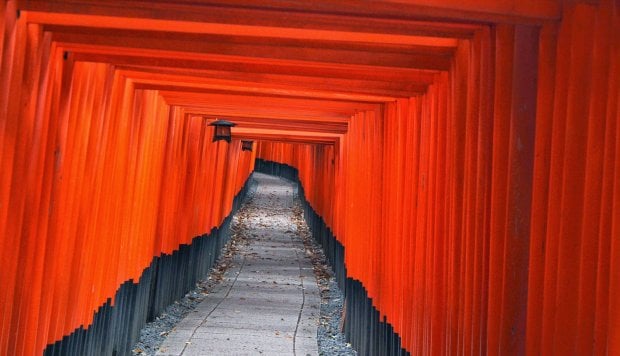
Yokoso Kyoto!
This is a three-part series dedicated to travelling to Kyoto:
1. The Ultimate Kyoto Travel Guide
2. Exploring Kyoto : The City
3. Exploring Kyoto : Day Trips (still in writing)
Kyoto is the former imperial capital of Japan for several centuries. It is often seen as the cultural and traditional capital of the country while Tokyo represents contemporary Japan.
However, despite its great historical value, the city often only gets allocated a day trip or a one to two days stay in a typical Japan itinerary. That is a great pity. My friends often asked me how much time they should allocate for visiting Kyoto and my answer would always be at least 5 days to just get a broad overview of what this city has to offer.
Firstly,
Where is Kyoto?
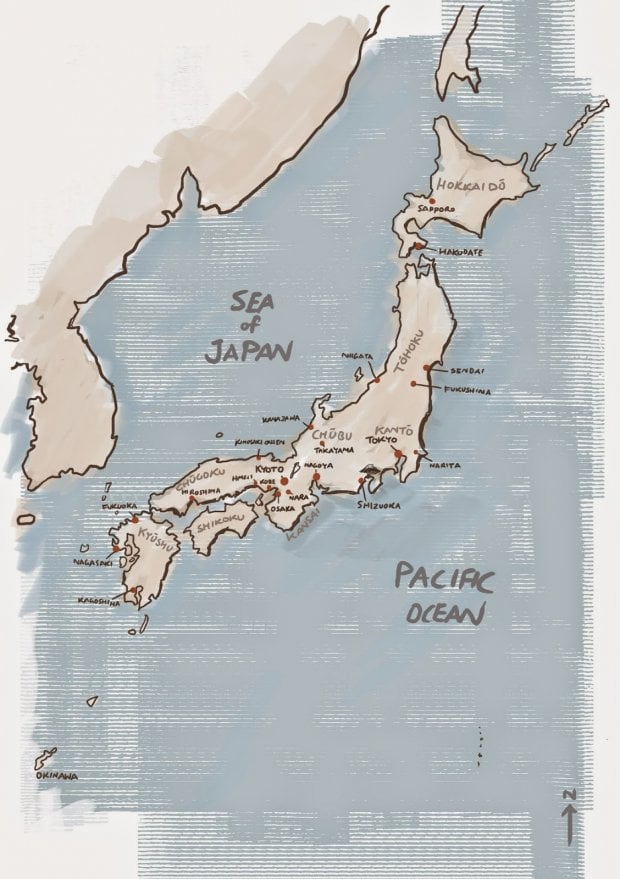
The distance between Kyoto and Tokyo is about 367 kilometres. In comparison, the distance from Joo Koon to Changi Airport from one end of the PIE to the other end is about 43 kilometres. Just about 8.5 times less than the distance between Kyoto and Tokyo, which covers Mt. Fuji, Shizuoka , the Kiso Valley, Nagoya and Japan’s largest lake, Lake Biwa in between.
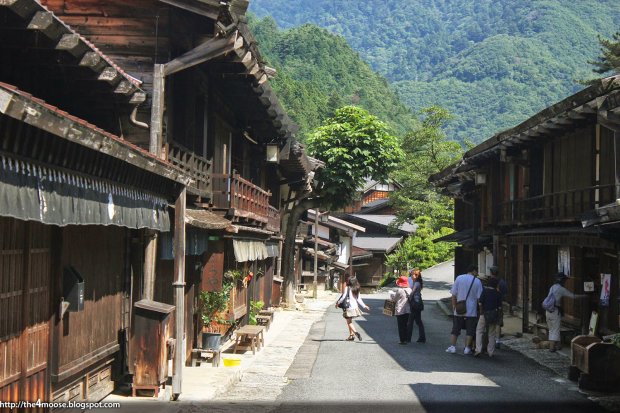
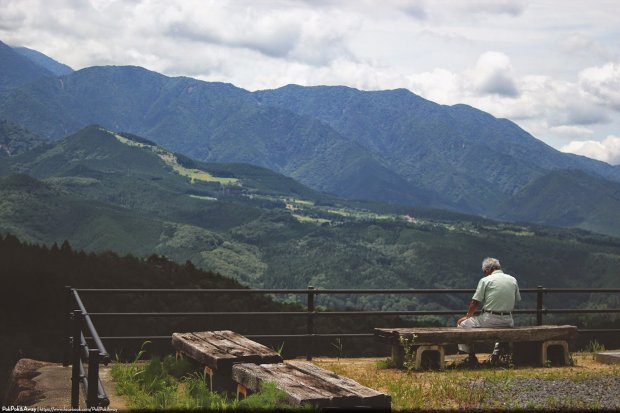
Kiso Valley, is one of the many places that are worth visiting on your journey en-route to Kyoto from Tokyo.
All these, you would easily miss within a 2 – 2.5 hours Shinkansen ride from Tokyo to Kyoto which goes to show how fast the Shinkansen is and also how much you would miss out in between that 367 kilometres between these two major cities. Kyoto is not near Mt. Fuji and Tokyo and there is a lot of places to see in between Kyoto and Tokyo.
Also read: Day-trip To Central Japan’s Kiso Valley: Tsumago and Magome
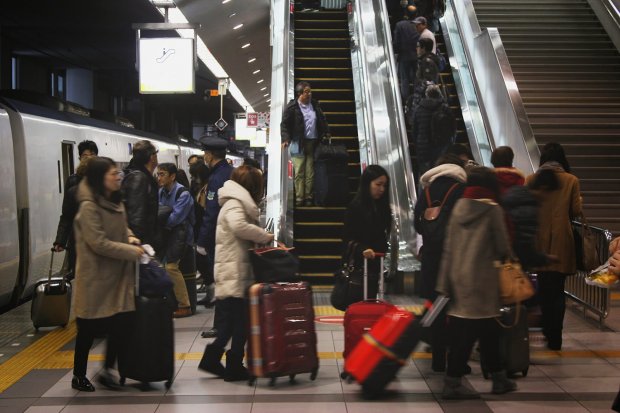
How to get in? (for non-drivers)
From Kansai International Airport
Most people who fly to Osaka is bound to arrive at the Renzo Piano designed Kansai International Airport located on a reclaimed offshore island near Osaka and Wakayama. The most direct way to get to Kyoto is to take the Haruka Limited Express. While the Japan Rail Pass covers this journey, the rail pass is overkill if you are spending several days in Osaka and Kyoto before embarking on long-distance rides or just planning to stay in Kansai only.
Instead, get a Haruka & Icoca Package which includes discounted tickets on the Haruka Limited Express and onward journey on any JR lines as well as an Icoca Card which is like an ez-link card with at least JPY1000 (approx. SGD11.42) to use on subways, private railway lines and buses.
Alternatively, you could take a bus, or use the Nankai Railway to transfer to a private railway line to Kawaramachi and Karasuma areas in the centre of Kyoto. For more detailed directions, I recommend reading up here.
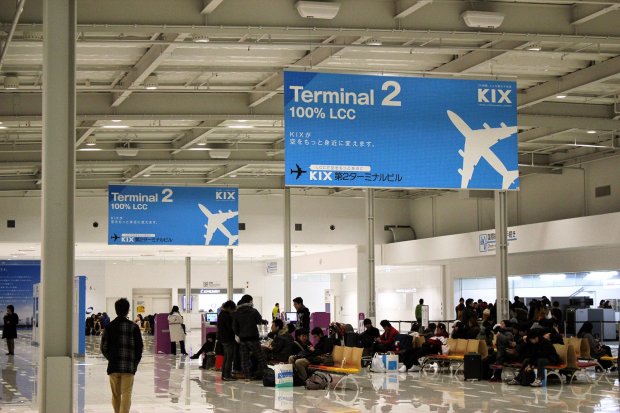
Kansai International Airport’s Terminal 2 serving Low-Cost Carriers.
Domestic flights | Budget airlines in Japan
In the past, it is unthinkable to consider flying from one city to another in Japan has ANA and JAL has a monopoly over the airfares and it can be quite costly. However, with the influx of budget airlines and more intense competition in the airline industry in Japan, you might just find a cheap or competitively priced airfares from Tokyo or Sappporo to Osaka or even from cities like Kagoshima and Sendai with affordable connections to Osaka Kansai International Airport which is the budget airline, Peach Aviation’s base of operations. From Osaka it is a direct connection to Kyoto via the Haruka Limited Express.
Airline websites: Peach Aviation | Vanilla Air | Jetstar Japan
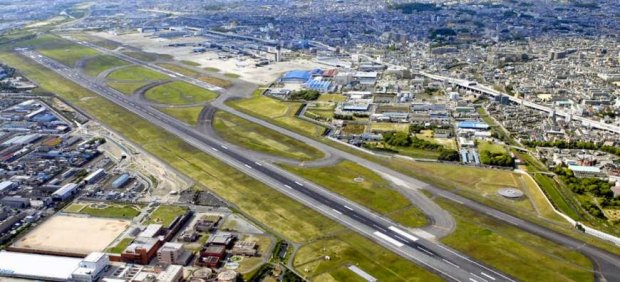
Image credits: Japan Times
From Osaka Itami Airport
If you are flying with ANA or JAL which would transit at Tokyo before flying down to Osaka, you might arrive in Osaka Itami Airport. From Osaka Itami Airport, you could take the Osaka Monorail to Minami-Ibaraki Station to transfer to a Hankyu Train to Karasuma or Omiya or Kawaramachi stations which are located in the central area of Kyoto.
To get to Kyoto Station instead, you could either get to Kyoto Station by subway from Hankyu Karasuma Station or transfer to a JR line at Umeda, Shin-Osaka, Osaka and Oyamazaki stations, it would require a couple of transfers, for more details use Hyperdia and Japantravelguide to find out.
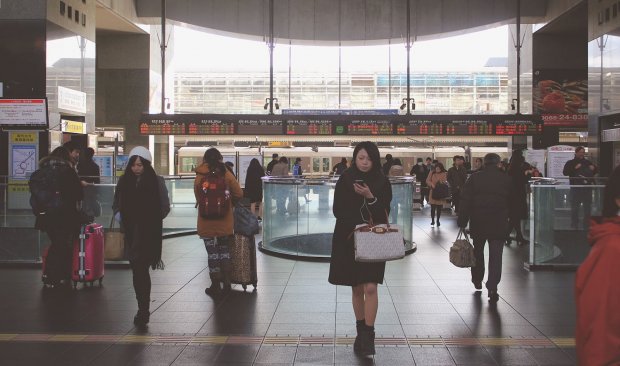
By shinkansen or train
The next most direct and common entry to Kyoto is by Shinkansen if you are coming from Tokyo or Nagoya in the east or perhaps Hakata to the west. You will arrive at Kyoto Station.
The question is how to get into Kyoto cheaply? The Shinkansen is no doubt the most expensive option and the reflex action is to get a Japan Rail Pass to cover that journey. However, do not just limit yourself to Tokyo and Kyoto if you opt to get the rail pass. Arrange for a few stops in between within the 7 days to fully utilize the rail pass and see more of Japan.
However certain travel agencies such as Sunrise Tours do offer packages which include discounted tickets on the shinkansen between Osaka, Kyoto and Tokyo or include a night or two in a hotel.
If you don’t mind entering Kyoto somewhat slower, there is a Seishun 18 Kippu Pass that covers all local JR trains for 5 consecutive days which you could use to travel from Tokyo to Kyoto or Nagoya to Kyoto with some stops in between.
For more value for money options on rail travel concerning Kyoto refer to the rail passes section below.
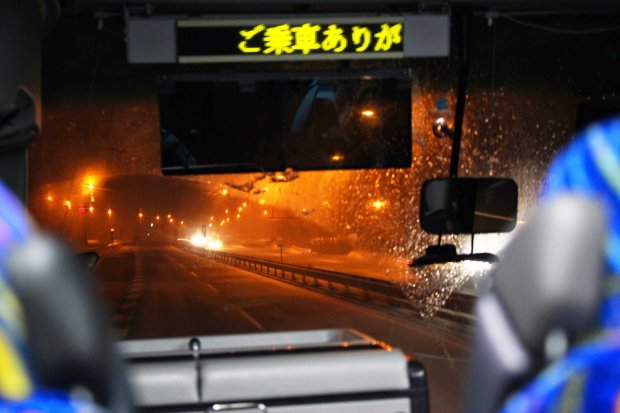
By bus
A cheap alternative form of transportation to Kyoto might be the overnight buses such as Willer Express bus which connects Tokyo’s Shinjuku to Kyoto Station. Willer Express offers a Non-Consecutive 3 or 5 Day Bus Pass for JPY10000 and JPY15000 respectively (roughly 115 to 180 SGD). If bus travel is your preferred method of getting around a few cities, it can save you quite a bit of money. The company also offers connections to Hiroshima and Hakata.
Kyoto is also connected to the popular Takayama region by Nohi buses.
For more information on the buses : Willer Express | Nohi Bus | Japan-Guide
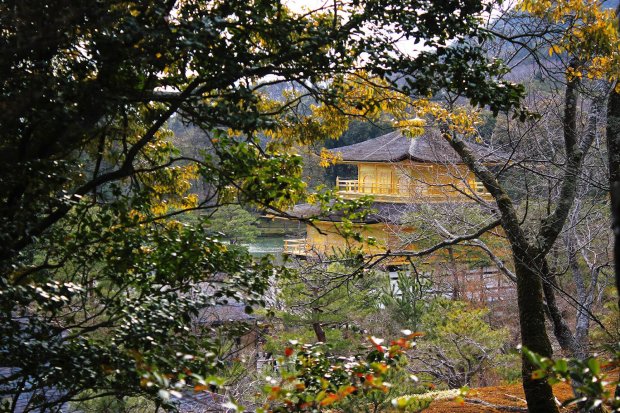
Kyoto and your itinerary
Kyoto is often just one of the stops in an itinerary to Japan. How does Kyoto fit into your itinerary? What are the alternatives besides the usual Osaka – Kyoto – Tokyo routes?
One of the most common itineraries is the Osaka – Kyoto Tokyo route where by a visitor would get to Kyoto from Tokyo via the Shinkansen using the rail pass, this segment shows you what variations is possible with that itinerary and some points to take note before you embark on that itinerary.
The Osaka – Kyoto – Tokyo
This is a popular route no doubt and if you have only 7 days in Japan, you will be highly tempted to get the rail pass to do this route. While the rail pass will pay off the return or one way trip between Kyoto and Tokyo, the pass is barely utilized in your stay in Tokyo, Osaka and Kyoto where its coverage for travel within these places are limited.
However, if you are intending to stop by some destinations in between Kyoto and Tokyo such as Nagoya and Matsumoto within the 7 days of travel, going for quantity of destinations rather than depth, the rail pass is highly recommended.
How much time do you have in Japan?
If you have only 5 -7 days to spare in Japan and plan to visit Kyoto, I suggest keeping the itinerary down to Kyoto and surrounding areas such as Nara and Osaka. Not only would this mean that you spend less on transportation but it would also give you more time to explore the Kansai region.
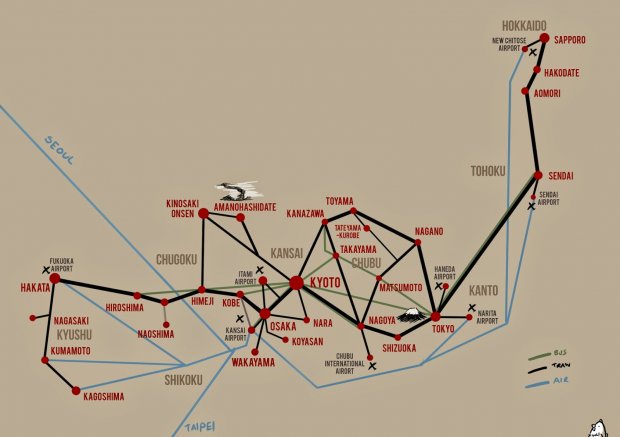
A rough route map showing how Kyoto can be part of your itinerary.
Where does Kyoto come in?
Where would you place Kyoto in your itinerary? First, consider what your priorities are for this trip. How much time do you have in Japan? Where are you flying in and out of the country? Kyoto has many connections to major destinations in Japan thanks to the transport infrastructure.
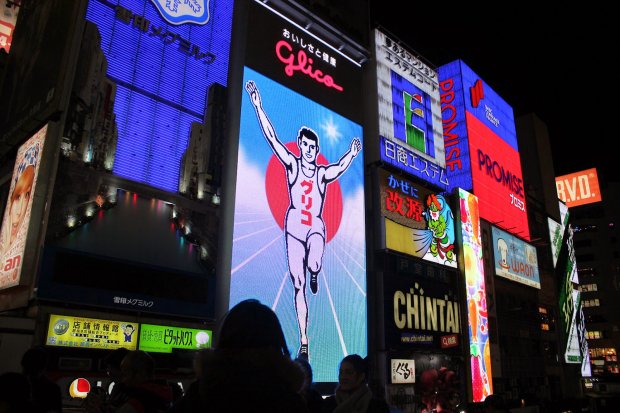
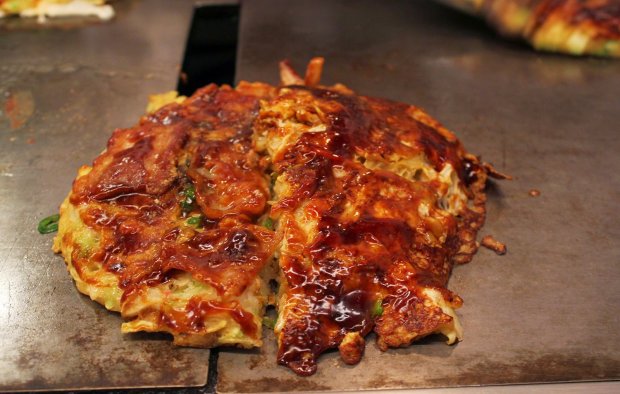
Dotonbori and Kiji’s Okonomiyaki in Osaka.
Starting from the most common:
Osaka | 大阪
This would normally come right before or after Kyoto, at the end or start of a trip next to the Kansai International Airport or before taking the shinkansen back to Tokyo. Osaka is a good choice because the connection between Kyoto and Osaka is affordable and connections to Kansai International Airport are plentiful and affordable as well. Furthermore, the city served as a contrast to Kyoto with its loud, vibrant urban centres and concrete jungle landscape. Osaka is also a good base to make trips to Himeji, Koyasan, Nara and Kobe.
If you have only 7 days to spare and intend to focus on Kansai, you could do a Kyoto – Nara – Osaka trip and 7 days might be just right to cover these places. For longer itineraries, Osaka could be end of a trip originating in Tokyo or Hakata, with a stop in Kyoto or the end of a wider loop in the Kansai region like Osaka – Okayama – Kinosaki Onsen – Kyoto – Nara – Osaka.
Osaka is also the beginning of the Takayama-Hokuriku Area Tourist Pass and it could be the end of beginning of an itinerary through Kyoto and Takayama such as a Osaka – Kyoto – Kanazawa – Takayama – Nagoya and vice versa.
For information on Osaka: Osaka Info | Japan Guide
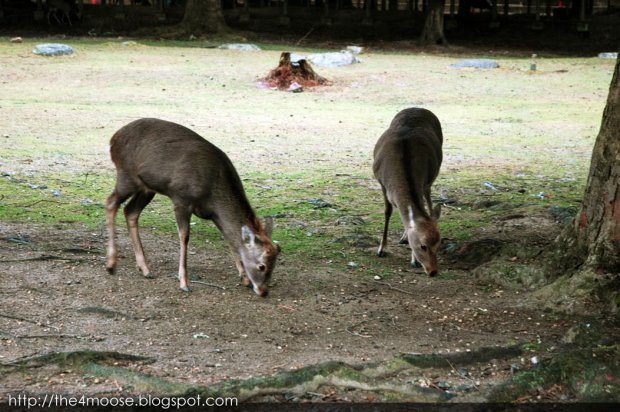
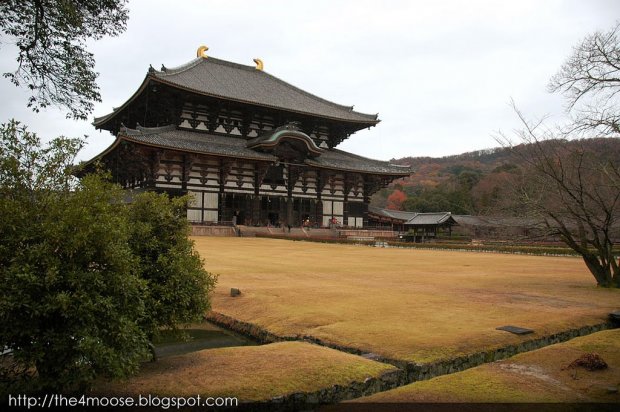
The Nara deers and the largest wooden building in the world : Todai-ji.
Nara | 奈良
Just south of Kyoto, Nara is the next most popular choice to travel to after Kyoto and some would opt to visit Nara as a day trip from Osaka or Kyoto. Nara is known for its free-roaming deers in the centre of the city as well as the Todai-ji (東大寺), the largest wooden building in the world.
In a concise Kansai Itinerary, Nara could be the next stop after Kyoto before ending at Osaka. For a 7 day trip, a Kyoto – Nara – Osaka with day trips out of Kyoto and Osaka itinerary is a good choice.
For information on Nara: Nara Sightseeing | Japan Guide
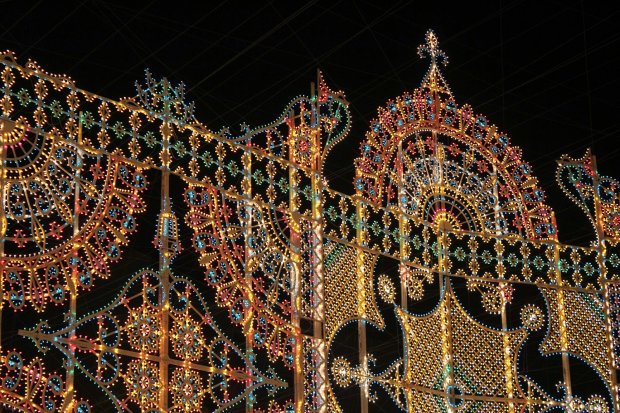
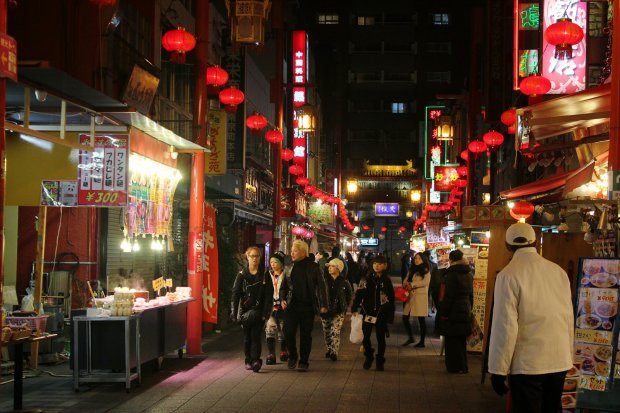
The annual Kobe Luminarie is held in December to commemorate the victims of the 1995 Great Hanshin Earthquake (top). Bottom : Kobe’s Nankinmachi (Chinatown).
Kobe | 神戸
Travelling westwards from Kyoto and Osaka is Kobe. While it is known for the terrible Kobe earthquake in 1995, Kobe is much more than that, with modern architecture to explore and a history as the first few ports to be opened to foreigners in the 19th century, the city’s foreign merchant districts as well as Chinatown is worth a visit.
Furthermore in December, the Kobe Luminarie (神戸ルミナリエ) is quite a spectacular night illumination event that you should visit. If your Japan itinerary involves travelling westwards to Hakata or Hiroshima, Kobe could be your next destination.
Kobe is also connected to the northern part of Hyogo region by rail, these destinations include the famed Takeda Castle as well as Kinosaki Onsen which can be done as part of a larger Kansai Region loop before or after Kyoto.
Kobe has connections to Kansai International Airport by high-speed ferry (about 30- 45 minutes), if you do not wish to end your trip at Osaka, Kobe could be an alternative.
For information on Kobe: Feel Kobe | Japan Guide
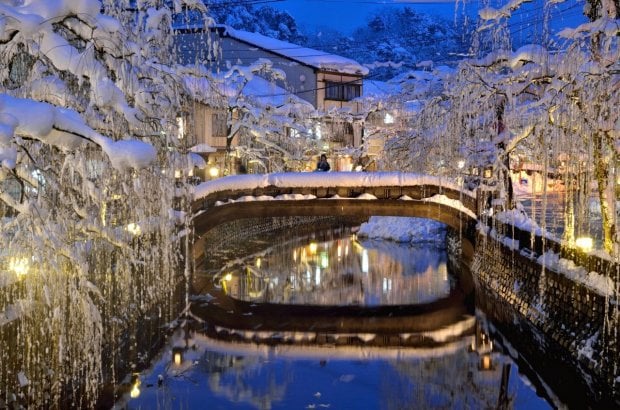
Kinosaki Onsen in Winter
Image credits: JNTO
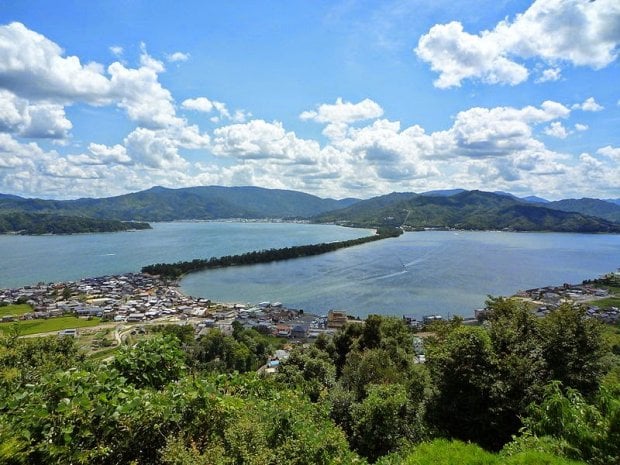
Amanohashidate
Image credits: osakaosaka, Wikimedia Commons
Kinosaki Onsen & Amanohashidate| 城崎温泉と天橋立
As mentioned before, these places could be done before Kyoto and after Kobe. Likewise, they are possible stops after Kyoto in an in-depth itinerary of the Kansai region.
Kinosaki Onsen and Kyoto are connected by a direct limited express train. Kinosaki Onsen is stunning in winter and known for its seafood harvest and crab season in winter.
One of the most famous features of the hot spring town dating back to the 8th century is its multitude of public bath houses with hot spring water. Visitors staying at a local ryokan in Kinosaki Onsen would have access to all the seven public bath houses. If you are not staying over, you could purchase a pass to enter the bath houses as well.
Located to the west is Amanohashidate (天橋立) or the “bridge in heaven” is one of the three most scenic views of Japan. While the rail passes only provide partial coverage to Amanohashidate, this could be a stop in the northern Kansai region itinerary that includes Kinosaki Onsen and coastal regions of Tajima and Tango.
The Tajima region was where the Tajima cattle which belongs to the Kuroge Wagyu (Japanese Black) breed were originally raised. The meat from the very best Tajima cattle (A4 or A5 ranking) would be certified as “Kobe beef”.
For information on Kinosaki Onsen and Amanohashidate: Kinosaki Onsen | Japan Guide
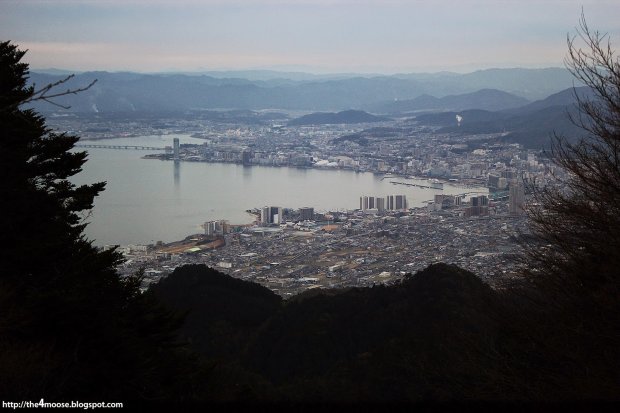
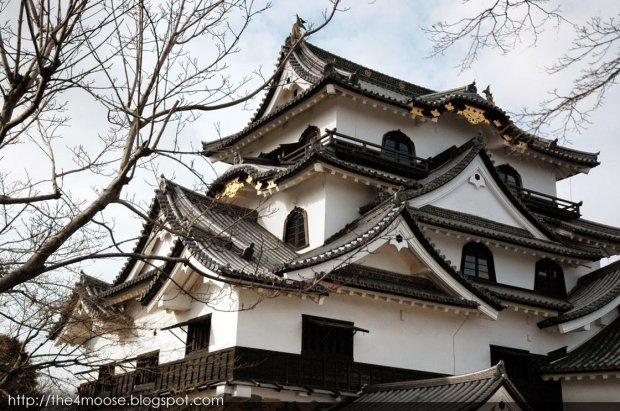
Shiga Prefecture & Lake Biwa | 滋賀県と琵琶湖
With the regional rail passes now extending up to Nagahama and Tsuruga. Visitors to Kyoto can now access the Shiga region where the largest lake in Japan, Lake Biwa is located. Destinations of interest include Omi-Hachiman, Nagahama and Hikone which could be done as a day trip in a trip between Kyoto and Nagoya. Hikone Castle is one of the few remaining castles that survived the post feudal era. The town is also known for its mascot: the Hikonyan.
While not as famous the Kobe beef, Omi beef from the Shiga region is highly prized as well with earthy and rich flavours and textures than rivals Kobe beef.
For information on Shiga: Go Biwako | Japan Guide
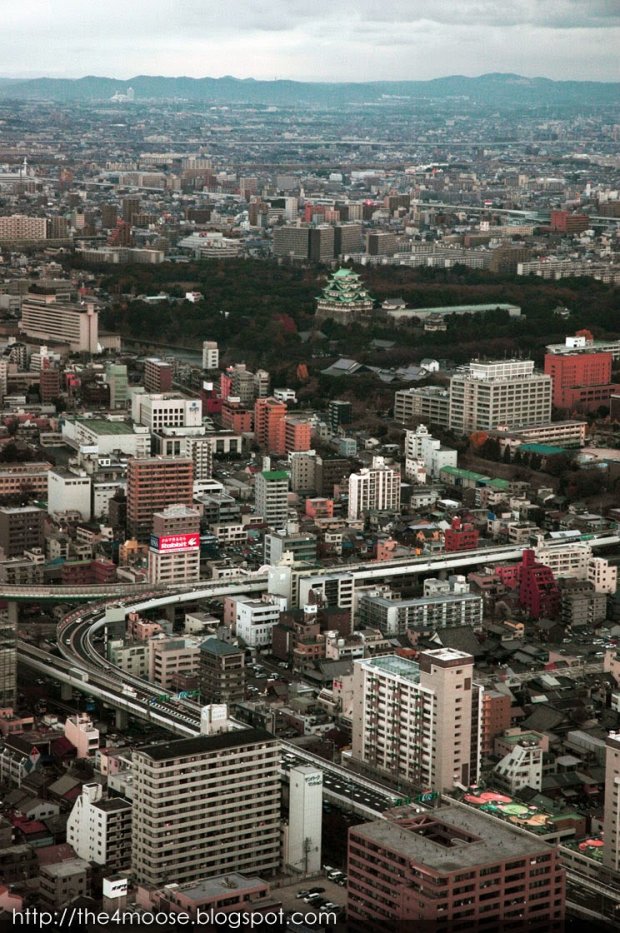
Nagoya | 名古屋
Right after Maibara, Nagoya is the next major stop after Kyoto on the Tokkaido Shinkansen. Nagoya is the gateway to Kiso Valley and Takayama from the south. The shinkansen trains bound for Tokyo also goes through here. Hence, this could be in your itinerary after Kyoto to visit the Chubu region or it could be one of the stops within your 7 days from Tokyo to Kyoto with the rail pass.
Nagoya is a major industrial and transport hub with a portfolio of contemporary architecture and a history as the former stronghold of the Tokugawa clan that came to rule Japan for the entire Edo period which you can trace in the Nagoya Castle. The city is known for torpedo prawns and chicken dishes including chicken sashimi.
As there are also international flights operating out of Nagoya, this could also be the beginning or end point of your itinerary. A sample itinerary with Nagoya with exploration of the Chubu region could be Nagoya – Takayama – Kanazawa – Kyoto – Osaka or vice versa. This route is covered by the Takayama-Hokuriku Tourist Pass.
From Nagoya, you could also explore the lesser known region of Mie, home to the most important Shinto shrine: the Ise Shrines, a UNESCO World Heritage Site.
For information on Nagoya: Nagoya Info | Japan Guide
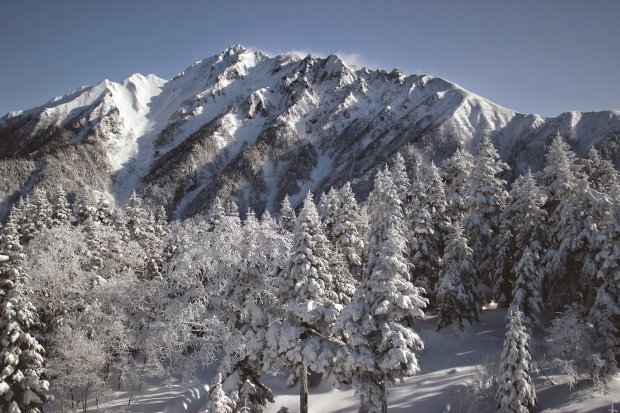
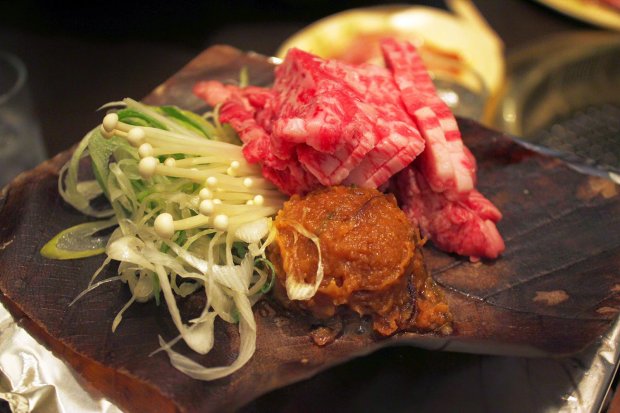
Shin-Hotaka (top): An hour away from Takayama Station & Hida Beef with Hoba Miso (bottom).
Takayama and the Hida Region
Buses that connect Kyoto directly with Takayama, the heart of the Hida region. Takayama is also known as “Little Kyoto” with its well-preserved historical core. The city is the gateway to the breathe-taking sceneries around the Japanese Central Alps such as the rural villages of Gokayama and Shirakawa-go.
The Hida region is known for its sake and regional food such as miso paste especially hoba miso, which refers to food seasoned with sweet, honey-like miso and grilled on magnolia leaves. Of interest to meat lovers is the regional Hida beef.
It is also connected by train to Kyoto via Toyama from the north and Nagoya from the south. Takayama and Hida region could be a top after Kanazawa & Toyama before ending in Nagoya or vice versa.
For a Tokyo – Kyoto itinerary, this could be after Nagoya and before Toyama before ending in Kyoto to make full use of the Japan Rail Pass.
For information on Takayama and the Hida Region: Hida Takayama | Japan Guide
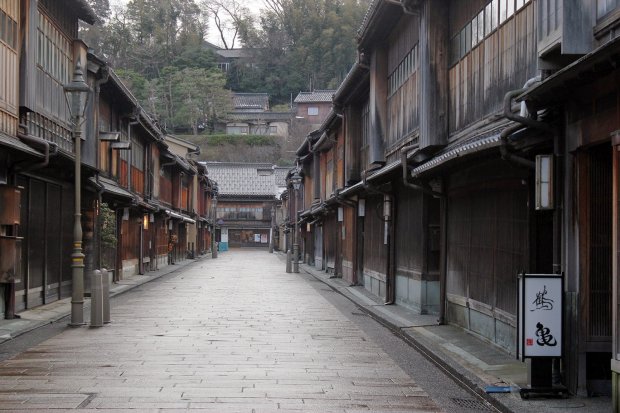
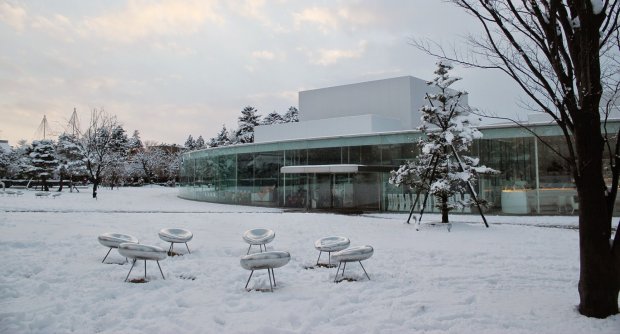
Higashi Chaya District (top) and the 21st Century Museum of Contemporary Art by SANAA (bottom)
Kanazawa and the Hokuriku Region
A highly underrated city and region, Kanazawa is known for its seafood harvested from the Sea of Japan such as crabs in the winter season, contemporary architecture, a myriad of traditional crafts such as gold leaf production (including edible gold leaf) and the highly ornamental Kutani porcelain. Like Kyoto, Kanazawa was spared from the destruction of WWII and as a result many historical buildings were left intact including the chaya districts where the geishas work.
With the introduction of the Hokuriku Shinkansen (covered by the Japan Rail Pass) in March 2015, Kanazawa could be the alternative northern route to Tokyo via Nagano and Toyama. A sample itinerary you could do is Osaka – Kyoto – Kanazawa – Toyama – Nagano – Tokyo with day trips or short excursions to Shirakawa-go and Takayama from Kanazawa.
For travellers interested in visiting the Tateyama Kurobe Alpine Route from Kyoto, you could consider entering the route from Toyama, which is connected to Kyoto via the Thunderbird Limited Express train and also connected to Tokyo via the Hokuriku Shinkansen from March 2015 onwards.
For information on Kanazawa and the Hokuriku Region: Kanazawa Tourism | Japan Guide
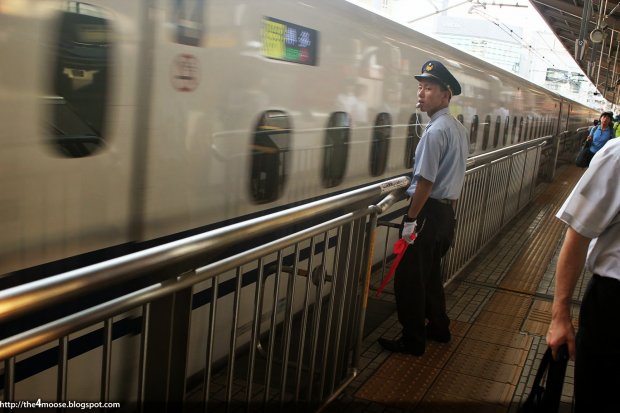
Tokyo doesn’t have to be your next stop.
And many more…
These are some of the suggestions to help you place Kyoto in your itinerary but these are some of the more direct connections with reasonable travelling times. There are definitely more destinations with the Japan Rail Pass or regional rail passes. For example you could skip Kobe and Osaka and head straight to Okayama, Himeji and Hiroshima as a stop before Hakata or Himeji as a stop before Kinosaki Onsen depending on your trip’s focus.
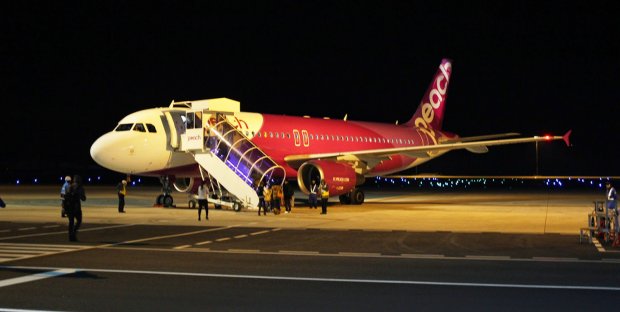
Budget Airlines like Peach offers affordable airfares to Taipei and Seoul.
Beyond Japan?
Likewise, a concise Kansai Loop of Kyoto – Osaka and Nara could be combined with a round trip to Hokkaido, Okinawa and even Seoul (with Peach Aviation) from Osaka. If you are based in Taipei, the same concise loop could be done with return flights from Taipei as well.
The return flights between Osaka – Seoul and Taipei – Osaka could be as low as SGD175 – 300 by Jetstar or Peach Aviation. With a cheap ticket to Taipei such as Tiger Air’s SGD210 in a promotion in March 2015, you could even combine a trip to Taipei and Kansai for an airfare less than SGD650.
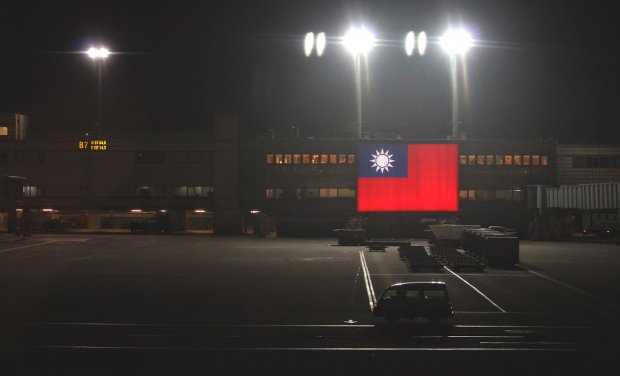
Some airlines would allow you to book open-jaw tickets like ICN – KIX or KIX – TPE, of which you could do the Kansai loop of Osaka – Kyoto – Nara and continue onwards to Taipei and Seoul. Thai Airways for example offers the Singapore to Osaka – Taipei to Singapore option forSGD550 (Mastercard Promotion) and Malaysian Airlines offers this at SGD585 (Economy Promo Fares).
Airfares from Osaka to Taipei by Peach Aviation (one-way) cost about SGD100 – 175. Hence, you could combine the open-jaw and one way ticket to do a Taipei – Kansai itinerary as well for about SGD650- 750.
For Singapore to Osaka – Seoul to Singapore, Malaysian Airlines offer this at SGD470 while Thai Airways offer this at SGD630. The airfares from Osaka to Seoul by Peach Aviation cost about SGD85 to 125. Therefore, it is also possible to a Kansai Loop with Seoul for an airfare of around SGD575 – 800.
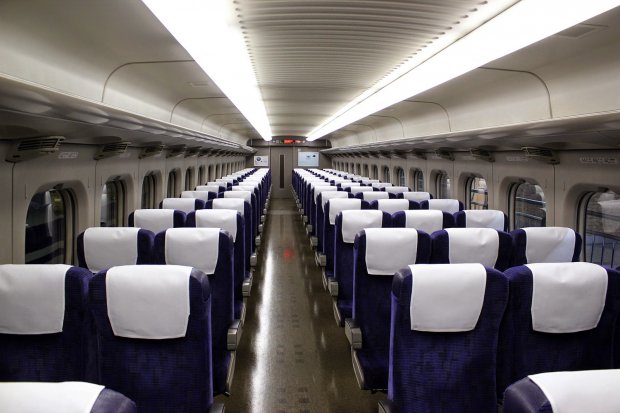
Onboard the Shinkansen from Osaka to Okayama.
Kyoto and the rail passes
The Japan Rail Pass
7-Days | JPY29110 / SGD335 (Consecutive)
The Japan Rail Pass is a very powerful tool (and pricey too). The rail pass easily covers the shinkansen ride from Tokyo to Kyoto (a popular route) and also covers the journey from Kyoto to Hakata in Kyushu.
If you are coming from Osaka and Kyoto is somewhere you want to explore in-depth then I strongly recommend only using the Japan Rail Pass on the day you set off from Kyoto towards Tokyo rather than using it at arrival in Osaka Kansai International Airport to get to Kyoto or Osaka. This is because the rail pass is has limited coverage in both Osaka and especially Kyoto where non-JR lines and buses are more useful for getting around to many of the attractions.
Similarly, if you are coming in from Tokyo, you could plan for your 7-day rail pass to end upon arrival in Osaka or Kyoto.
Also read: Going Japan? Tips and Advice on Japan Rail Pass
Limitations for yourself and your rail pass
When you use the Japan Rail Pass upon arrival in Osaka, you limit yourself to reach Tokyo within 7 days. This not only restricts your itinerary within the Kansai region by making them fit the 7 consecutive days timeline of the rail pass but also limit the full extent of the rail pass’s capabilities to local JR trains where it should be used for inter-city trains to further destinations instead where rail journeys are significantly more expensive.
More information on the Japan Rail Pass: Japan-guide.com | Japan Rail Pass
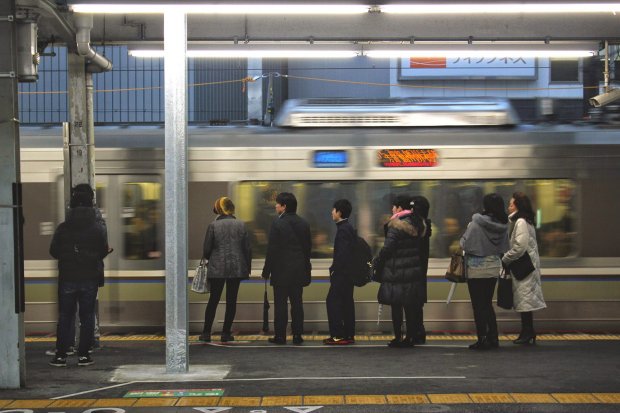
Other rail passes
The JR Japan Rail Pass is not the only rail pass that covers Kyoto. There are at least 4-5 kinds of other rail passes out there to cater to your travel needs and here are some points to consider.
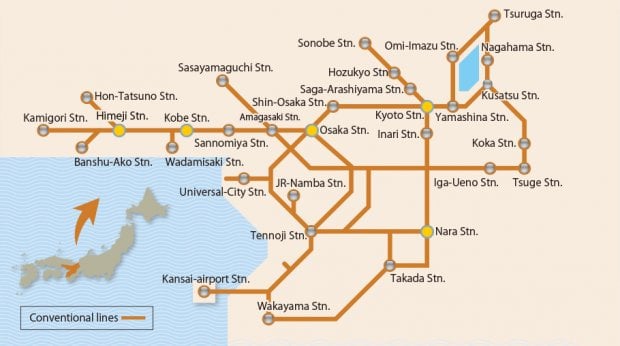
Image credits: West Japan Railway Company
JR West Kansai Area Pass
1 – 4 Days | JPY2200 – 6300 / SGD27 – 75 (Consecutive)
Comes in 1-4 day options and cost about JPY2200 – 6300 (SGD27-75), this rail pass covers the Haruka Limited Express between Kansai International Airport, Osaka and Kyoto.
One of the most popular ways to use this pass as an alternative to the Haruka Icoca package is to use it to take the Haruka Limited Express train to Kyoto and use it to day a day trip to Uji and Arashiyama on the same day. With the new extension, you could push the value of this pass by making a day trip down to Hikone or Omi-Hachiman.
If you are arriving from Tokyo side, this pass could be used as a way to get to Kansai International Airport as well from Kyoto, Kobe and Nara. Osaka has rather affordable options to get to the airport and this pass is not very good for value if you are heading there from Osaka especially if you stay around Namba.
More information on the JR West Kansai Area Pass: Japan-guide.com | JR West
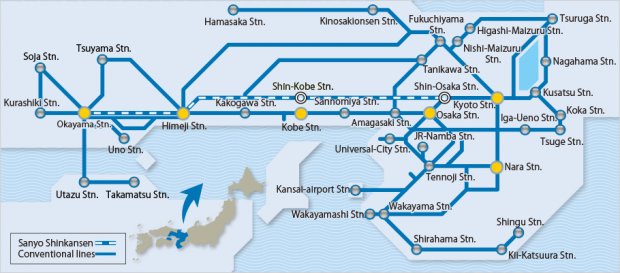
Image credits: West Japan Railway Company
JR West Kansai Wide Area Pass
5-Days | JPY8500 Online / SGD98 (Consecutive)
This is a power-up version of the Kansai Area Pass and offers shinkansen connections up to Kurashiki and Okayama from Shin-Osaka. On paper, the pass doesn’t cover Kyoto – Shin-Osaka Shinkansen connection but apparently some of my friends managed to get by.
This pass is really useful if you are intending to explore destinations like Naoshima via Okayama, Himeji, Kinosaki Onsen and Kurashiki from your base in Osaka or Kyoto. The return trip between Osaka/Kyoto to Kinosaki Onsen/Okayama via Shinkansen would easily pay off the cost of this rail pass.
More information on the JR West Kansai WIDE Area Pass: Japan-guide.com | JR West
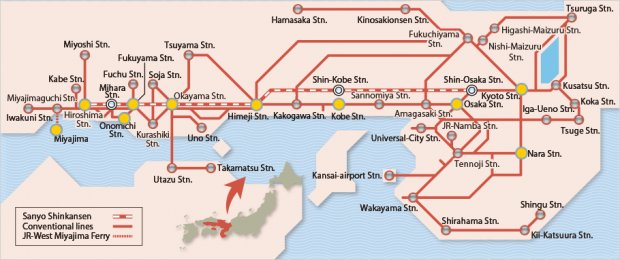
Image credits: West Japan Railway Company
JR West Kansai-Hiroshima Area Pass
5-Days | JPY13000 Online / SGD152 (Consecutive)
This is a cheaper alternative to the JR West Sanyo Pass and caters mainly to the travellers who intend to visit Miyajima and Hiroshima while still based in Kansai region (flying in and out of Osaka and staying in Kyoto/Osaka).
One of the suggested ways to use this pass is to use it after exploring Kyoto, Nara and Osaka or use it to explore Hiroshima, Miyajima, Himeji, Naoshima, Kinosaki Onsen and Okayama in between your travels to Kyoto and Osaka like a 5-Day excursion.
The pass covers the JR Shinkansen connection from Shin-Osaka to Hiroshima station as well as local trains to Uno to get to Naoshima by ferry (not covered) and train as well as ferry to Miyajima (covered).
More information on the JR West Kansai-Hiroshima Area Pass: Japan-guide.com | JR West

Image credits: West Japan Railway Company
JR West Sanyo-San’in Area Pass
7-Days | JPY19000 Online / SGD220 (Consecutive)
This rail pass covers the shinkansen connection between Hakata Station in Kyushu and Shin-Osaka. Similar to the Kansai-Hiroshima Pass, it is catered for travellers who intend to visit Hiroshima and Miyajima except this is recommended for travellers who intend to fly into Fukuoka in Kyushu and fly out via Osaka or vice versa.
While there are overnight bus options to connect to Hiroshima and Kyoto from Hakata, this rail pass is a fuss-free, faster and convenient way to get from Kyushu to Kansai and vice versa while stopping by the Sanyo area to visit places like Miyajima, Hiroshima, Tottori (for the sand dunes), Okayama and Himeji.
This rail pass, unlike the Japan Rail Pass, also allows you to take and make seat reservations on the Nozomi and Mizuho Shinkansen trains. As such, it has the perks of a Japan Rail Pass but more focused on the Kyushu – Kansai route and at JPY19000 (approx. SGD217), this is a cheaper than getting a JPY29110 (approx. SGD332) 7-Day JR Rail Pass and using it for the same route.
More information on the JR West Sanyo-San’in Area Pass: Japan-guide.com | JR West
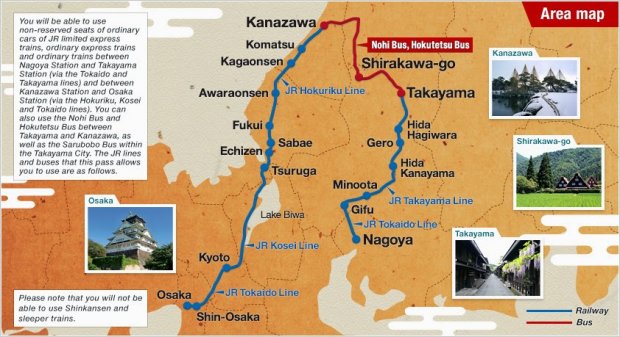
Image credits: Takayama – Hokuriku Area Tourist Pass
Takayama – Hokariku Area Tourist Pass
5-Days | JPY10500 / SGD125 (Consecutive / Available till 26th June 2015)
This is a pretty good pass if you are intending to visit Shirakawa-go, Kanazawa and Takayama from Osaka, Kyoto or Nagoya and do not intend to purchase the Japan Rail Pass. A return train trip from Kyoto to Kanazawa would easily pay off the cost of this pass and one of the perks and also a major weakness of this pass is that it covers the route between Kanazawa and Takayama via Shirakawa-go BY BUS. This meant that the trains between Kanazawa and Takayama are not covered at all.
In the event if the bus is fully booked or heavy snowfall caused the buses to be fully booked between Kanazawa and Takayama, you would have to seek other alternatives (at additional costs) to get from point A to point B.
Nonetheless it is still a pretty good alternative that covers the costs for the trains and some of the buses to explore the Hida region. Also a useful pass if you are flying in Nagoya and out Osaka or vice versa.
More information on the Takayama – Hokuriku Area Tourist Pass: Japan-guide.com | Tourist Pass
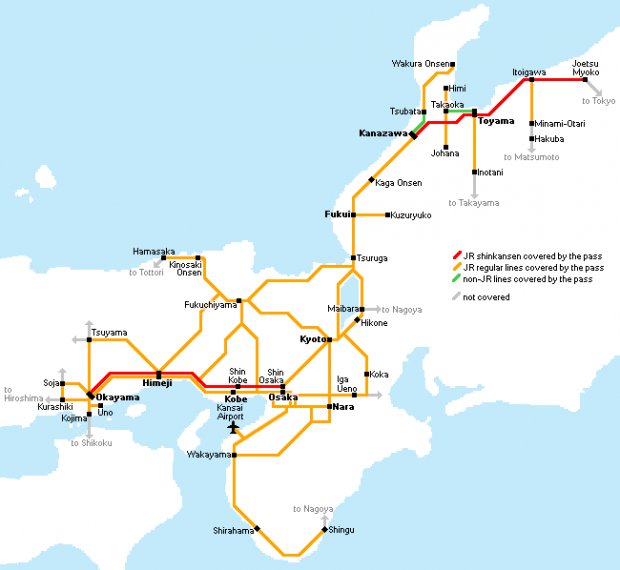
Image credits: West Japan Railway Company
Kansai – Hokuriku Area Tourist Pass
7-Days | JPY15000 / SGD175 (Consecutive / Available from 14th March 2015)
This new pass is aimed at travellers keen to visit Kanazawa and the Hokuriku region as well as parts of the Kansai region like Naoshima through Okayama. The pass roughly combines the coverage areas of the Kansai Wide Area Pass and the Hokuriku Area Pass into a single pass.
This is an excellent pass to explore the often overlooked region of Hokuriku and northern Kansai and it even allows access to the new Hokuriku Shinkansen from Kanazawa up till Joet Myoko including Toyama where you could visit the Tateyama Kurobe Alpine Route.
However, I recommend only using this pass before or after your trip to Kyoto or Osaka if possible and make full use of this pass to make trips to places like Kinosaki Onsen, Okayama and the Hokuriku region.
More information on the Kansai – Hokuriku Area Tourist Pass: Japan-guide.com
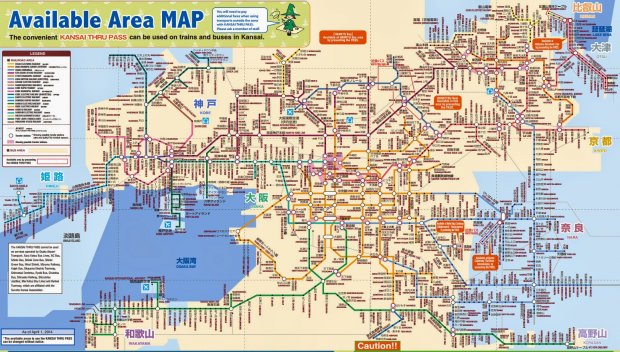
Image credits: West Japan Railway Company
Kansai Thru Pass
2 – 3 Days | JPY4000 – 5200 / SGD47 – 62 (Non-Consecutive)
The Kansai Thru Pass is the opposite of the JR Passes, it covers for almost all non-JR transportation such as buses, tramways, cablecars and trains. Another perk is that it is non-consecutive which means you can use the pass to get from say Kyoto to Nara or Osaka to Koyasan only after exploring Kyoto or Nara which the need to cram your visits within 3 days.
This pass is good for exploring Kansai region if your base is in Kyoto and Osaka and perhaps Kobe as well. While the private railways are not as convenient and fast as the JR inter-city connections, it has extensive coverage in the region such as the transportation from Namba to Koyasan, a World UNESCO Heritag Site or from Kyoto to Kurama, Uji and Nara.
The pass also covers the Nankai trains between Kansai International Airport and Namba in Osaka.
More information on the Kansai Thru Pass: Japan-guide.com | Kansai Thru Pass
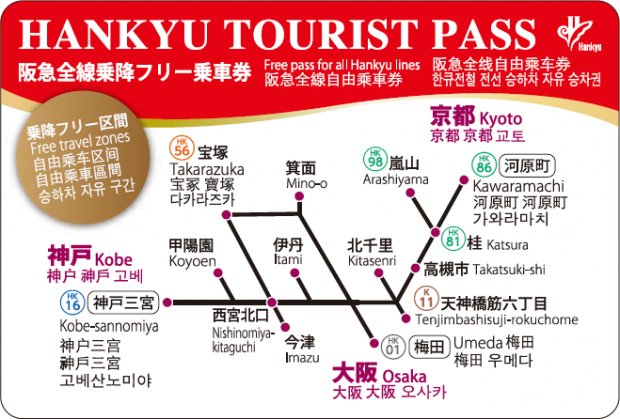
Image credits: Hankyu – Hanshin Railway Company
Hankyu Tourist Pass
1 -2 Days | JPY700 – 1200 / SGD9 – 15 (Non-Consecutive)
Valid only for Hankyu Railway Lines the connect Kawaramachi and Karasuma areas in the centre of Kyoto to Osaka’s Umeda station as well as Kobe’s Sannomiya Station via Juso.
Offered by the Hankyu Rail Company, one of the perks of their pass is that it is non-consecutive. If your itinerary is based mainly around Kobe, Osaka and Kyoto and intend to take a day trip to Osaka from Kyoto or vice versa, this pass might come in handy as it offers a decent connection between Umeda Station in Osaka, Sannomiya Station in Kobe via Juso and Kawaramachi station located opposite Gion, across the Kamo-gawa.
To fully utilize this pass however and compete with the JR-passes, you would have to use it to combine with excursions and inter-city travels between Osaka, Kyoto and Kobe. Some ideas include using it visit Arashiyama, Mount Rokko and the Katsura Imperial Villa. This pass would be useful for travellers who stay around the Kawaramachi and Karasuma areas in Kyoto as well as Umeda area in Osaka.
More information on the Hankyu Tourist Pass: Osaka Info | Hankyu Railways
Besides Hankyu, there are also different railway passes by various private companies:
Keihan Railways | Eizan Railways (jp)
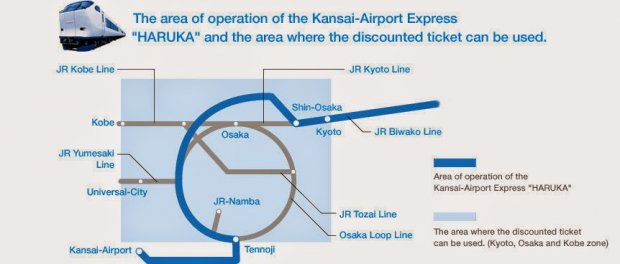
Image credits: West Japan Railway Company
Haruka and Icoca
JPY3060 – 4060 / SGD38 – 49 (One-way or Return Rides on the Haruka Limited Express + Pre-paid Card)
Technically, this is not a rail pass but this is one of the most useful offers if you are planning to visit Kyoto and fly in and out of Kansai International Airport. The price includes a one-way or return ticket on the Haruka Limited Express to Tennoji , Shin-Osaka and Kyoto Station and at the same time, comes with a pre-paid Icoca card that is like the ez-link card with JPY1500 (approx. SGD17) to spend on subway rides. The Icoca can be used for the Kyoto Subway, JR railway lines and some of the private railway lines such as the Keihan Railways. Depending on how you plan your sightseeing, this would come in useful and convenient to use as well without the need to purchase single tickets with cash.
The tickets on the Haruka Limited Express also covers your onward journey on the JR line within a given zone as long as you don’t leave the station area, for example, you can take the Haruka Limited Express to Tennoji then transfer to JR-Namba.
This perk is most useful when planning a return trip if you are staying in Osaka before or after Kyoto where you could board the train in Osaka or JR Namba and head to Shin-Osaka or Tennoji to take the Haruka Limited Express to the airport without the need to purchase an additional ticket to get to the stations served by the Haruka Limited Express.
More information on the Haruka and Icoca: Japan-guide.com | JR West
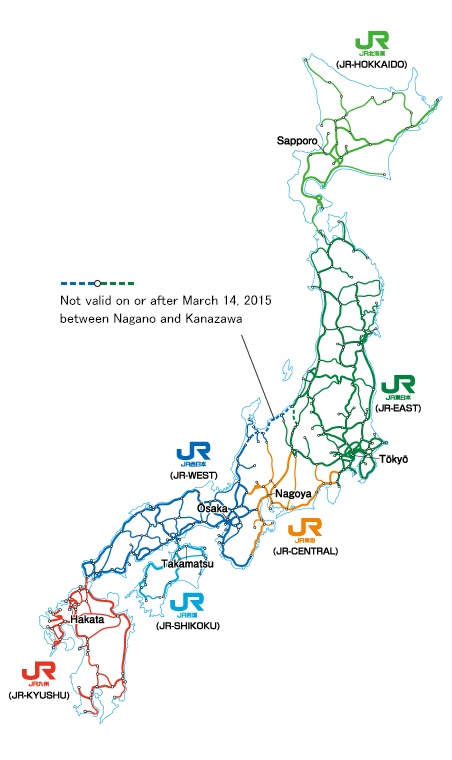
Image credits: JR East Railway Company
JR Seishun 18 Kippu
5 Days | JPY11850 / SGD140 (Consecutive)
This is similar to Deutsche Bahn’s Quer-Durchs-Land-Ticket. The JR Seishun 18 Kippu is a seasonal pass that offers unlimited travel on local and rapid JR trains nationwide over a period of five days.
If you are not rushing for time and budget is your top priority, you could use this pass to get to Kyoto from Osaka and onward to Nagoya is you are flying out from Nagoya without using the shinkansen. You could also use the pass to go to Arashiyama or Uji and Nara from Kyoto.
Unlike most of the rail passes, the JR Seishun 18 Kippu allows the sharing of the pass but each person would use up one of the ticket’s five days of validity.
An example given by Japan-Guide.com is as follows:
1 person uses it on 5 days (it can be a different person each day)
2 people share it on 2 days, and 1 person uses it on 1 day
3 people share it on 1 day, and 1 person uses it on 2 days
5 people share it on 1 day etc.
This pass is not valid on Limited Express trains such as the Haruka Limited Express or the shinkansen trains.
More information on the pass: Japan-guide.com | JR East
Getting around
The Japan Rail Pass will cover your journey to Arashiyama, Fushimi-Inari, Nijo Castle and Uji which are accessible via JR Railway lines. However, almost all of Kyoto’s city transportation is NOT COVERED by the Japan Rail Pass
This includes the subways which connects Kyoto Station to the Nijo Castle, Kyoto International Conference Centre and the junction of Shijo-Karasuma in the centre of Kyoto.
Other private railway lines include the Hankyu Railways, Keihan Railways and Eizan Railways which will connect Kyoto to places like Gion and Sanjo area near Pontocho. The Eizan Railways which begins at Demachiyanagi Station, the northern end of the Keihan Railways connects Kurama, Kibune and the cable car to Hieizan. All of these are not covered by the Japan Rail Pass.
You can get an overview of the railway systems and subway system of Kyoto by JR Pass here.
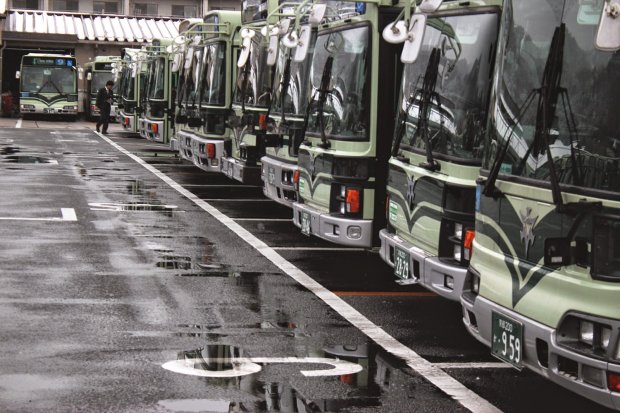
Bus | 京都バス
Wide coverage and affordable option
The best way to get around Kyoto besides walking is to take the bus. The best way to utilize the bus is to get a JPY500 (approx. SGD5.7) One Day Bus Pass which offers unlimited travel within a given zone covering almost all of Kyoto’s major attractions including Arashiyama.
When taking the bus, do take note that the street in front of Kyoto Station, Karasuma-dori and the central part of Kyoto between Shijo-Kawaramachi and Shijo-Karasuma tend to get very bad traffic in the late mornings till late afternoons. Be sure to get a Bus Route Map to find alternative routes to get around these traffic hot spots when you are travelling during the peak hours.
You get information about the bus routes and the one-day bus pass here: Kyoto City Web
On how to use the buses and tips check out: InsideKyoto | Visit Kansai
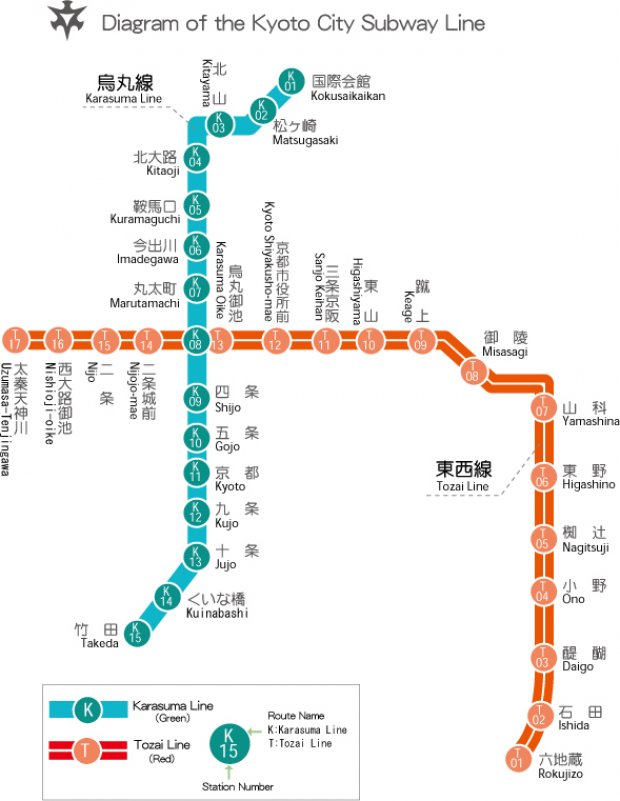
Image credits: Kyoto City Web
The subway | 京都市営地下鉄
Direct access to Kyoto International Conference Centre and Nanzenji
The subway has a limited coverage and only good for getting to the Kyoto International Conference Centre, Nijo Castle, Nanzenji and Kitayama where the Garden of Fine Arts designed by Tadao Ando is located. However the bus could cover all these routes as well.
There is a One Day Subway & Bus Pass that cost JPY1200 (approx. SGD13.7) or JPY2000 (approx. SGD22.84) for two days. There is also a one-day Subway Pass for JPY600 (approx.SGD6.8). Unless your sightseeing takes place mainly along the subway lines, these passes are not as good as the one day bus pass. Nonetheless, the subway could be an effective mode of transport system if used smartly.
Check out this article by Inside Kyoto on the subway systems.
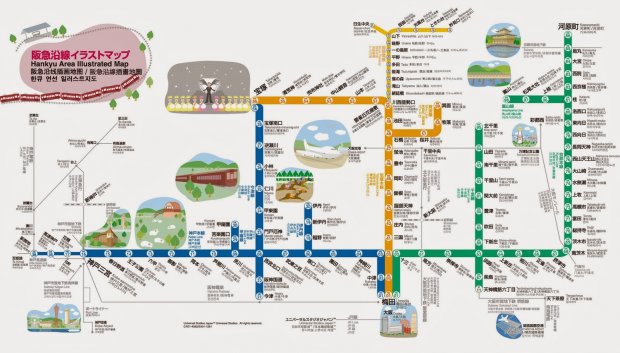
Image credits: Hankyu Railways
Hankyu Railways| 阪急電鉄
City Centre Access to Arashiyama and Katsura
Other railway lines of importance include the Hankyu lines which connect the centre of Kyoto (Shijo-Kawaramachi area) with Arashiyama via Katsura station. Katsura Station is the nearest station to the Katsura Imperial Villa, you would have to walk quite a bit to reach the imperial villa.
For more information about this rail service: Hankyu Railways
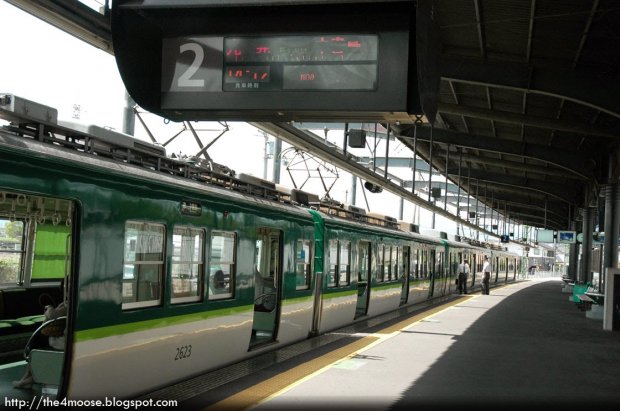
Keihan Railways| 京阪電気鉄道
Along the Kamogawa
The Keihan Line runs along the Kamogawa, its northern most station is Demachiyanagi where you could take the train to Kurama and Kibune on the Eizan Railway. The Keihan Line is good for those who are staying around Teramachi-dori and Gion area as you could use it to travel to Uji, Tofukuji and Nara via the Kintetsu Line or JR line.
For more information about this rail service: Keihan Railways
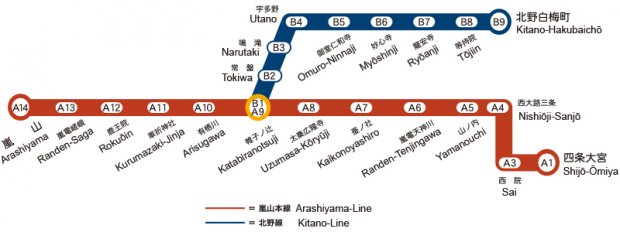
Image credits: Randen-Keifuku Railways
Randen-Keifuku Railways | 嵐電 – 京福電気鉄道
To the heart of Arashiyama
Lastly there is the Keifuku or Randen line which begins at Omiya Station and ends at Arashiyama station near the Togetsukyo Bridge, it is the nearest station to the major attractions of Arashiyama compared to JR’s Saga-Arashiyama Station or the Hankyu Arashiyama Station. The Randen line also provides connections to Ryoan-ji, Ninna-ji and Myoshin-ji temples (all of which would be a walk away from the station. However, buses remained the most direct connection to these attractions)
For more information about this rail service: Randen-Keifuku Railways
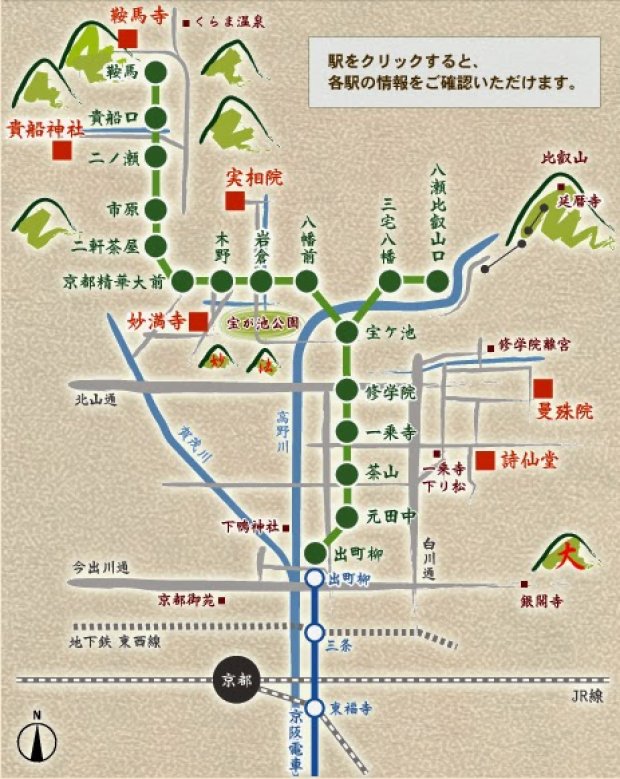
Image credits: Eizan Railways
Eizan Railways | 叡山電鉄
To Kurama, Kibune and Hieizan
The Eizan line begins at the northern end of the Keihan Line, providing access to Hieizan where you could board a cable car up to the mountain (closed in winter) and most importantly, the Eizan Line connects to Kurama and Kibune in the north.
For more information on the Eizan Railways: Eizan Railways (jp)
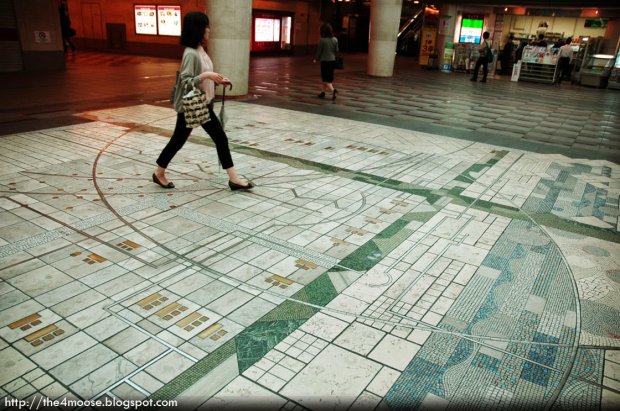
Bus “11”
Walking is the best way to enjoy Kyoto. As the city is rather compact and attractions tend to be located in clusters around the city especially around Gion, Kiyomizudera and the central area where Teramachi-dori and Pontocho are located. Hence, walking is probably the best way to explore Kyoto. While buses provide a convenient and affordable transportation option, it is dependent on the traffic conditions.
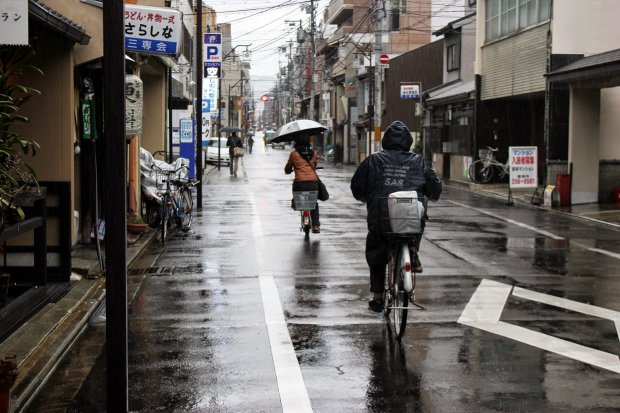
Cycling
Last there is the cycling option. Some hotels and hostels even offer bicycles for free or to rent. Otherwise you could check out these rental services and guides on how to explore Kyoto on a bicycle: InsideKyoto | Cycle Kyoto | Kyoto Cycling Tour Project | J-Cycle
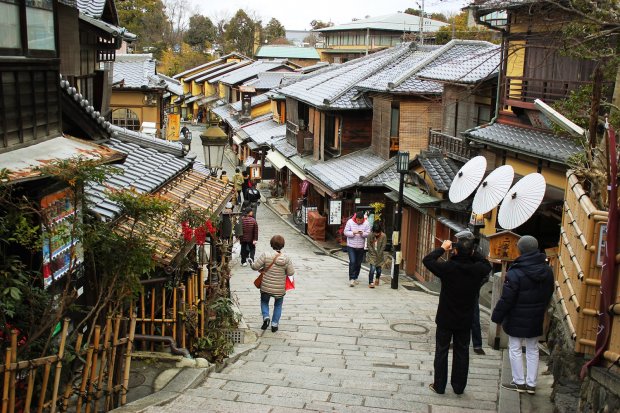
Where to stay in Kyoto
Depending on what are your plans for Kyoto, here is a run-down of where to stay in Kyoto. One of more unique ways to enjoy Kyoto is to stay in a machiya. In the past, this would have either been very expensive or difficult to arrange and the only way to do it affordably then is to stay at hostels or guesthouses. But with the advent of Airbnb as well as Machiya Accommodation websites, it is now possible to rent the entire machiya which is recommended if you are travelling in a big group.
Also read: Top 20 Historic Japanese Inns You Can Stay In
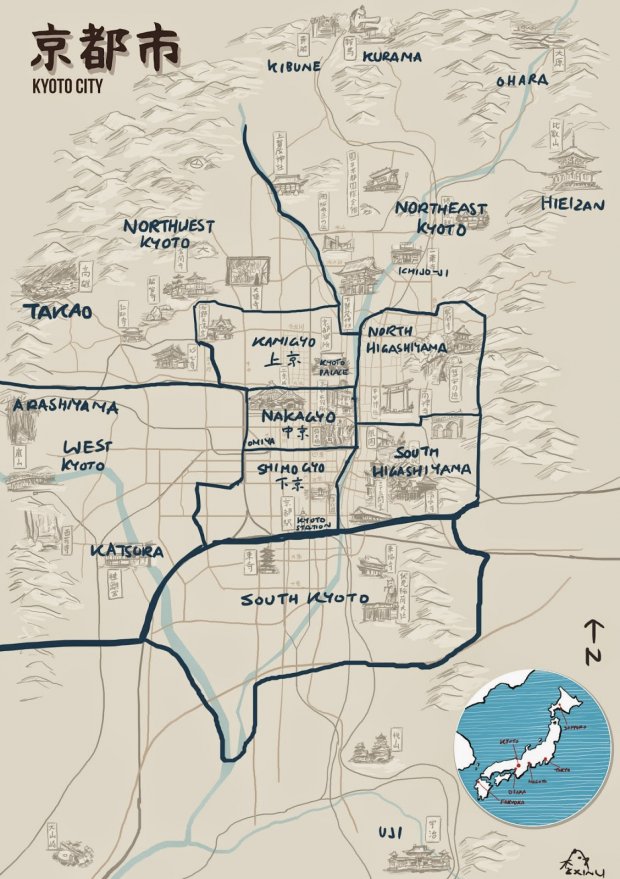
Shimogyō-ku (下京区)
Shimogyo-ku covers the area along Gojo-dori and Kyoto Station itself.
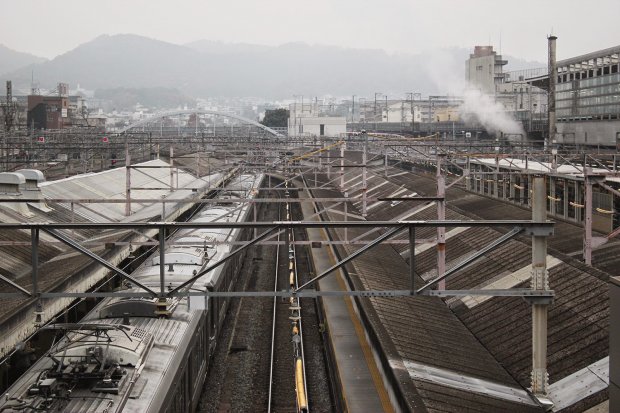
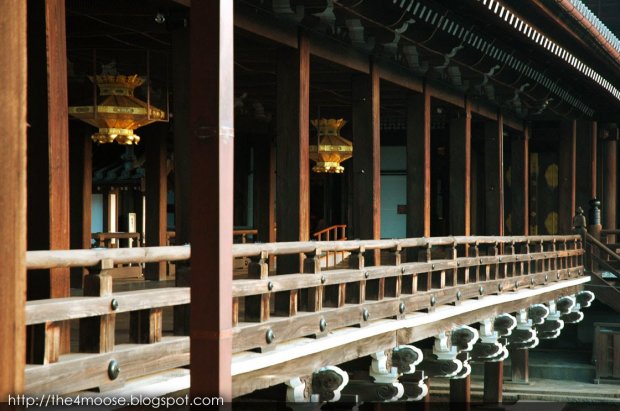
Kyoto Station and the Nishi Hongan-ji.
Kyoto Station Area | *****
The area around the station is a good base to explore Kyoto and at the same time being able to get out of the city to explore places like Osaka and Nara due to its easy access to the nation-wide JR Network as well as private railway lines to nearby cities. Hostels are numerous around here and hotels are plentiful.
To explore Kyoto by bus, the station is a convenient spot with numerous buses going to almost every part of Kyoto and there is a subway line that connects you to some attractions in the city, hence this is a good base for both travelling within Kyoto and making day trips out of the city.
Some accommodations in the area:
Piece Hostel Kyoto – A hostel with great design. Was awarded Good Design Award in 2013.
Kyoto Hana Hostel – A chain of hostels including J-Hoppers, offers discount if you stay in their hostels for a number of days.
Backpackers’ Hostel K’s House
Hotel Keihan Kyoto – An affordable mid-range hotel.
Ibis Styles Kyoto Station Hotel – L’Accor’s only property in Kyoto and next to the station.
Dormy Inn Premium Kyoto Ekimae
Hotel Granvia Kyoto – Upscale hotel located directly above Kyoto Station.
JP Traditional House Japanese Room (Airbnb)
B&B Keiko (Airbnb)
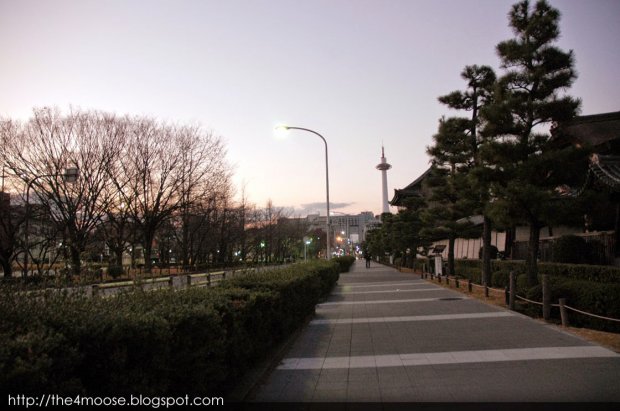
Kyoto Station is quite a long walk from Gojo-dori.
Along Gojo-dori| ***
North of Shimogyo-ku area and located along Gojo-dori are a couple of hotels and hostels. The main access to this area is by subway and buses. To get to Kyoto station, it is quite a long walk and using the subway could is costly for the short distance covered. The nearest stations are Gojo on the subway line and the Kiyomizu-Gojo Station on the Keihan line that you could use to travel to Uji or along the Kamogawa such as Gion etc.
Situated between the lively Shijo-dori and Kyoto Station, Gojo area is of walkable distance to both and is relatively quiet compared to the two areas. You can explore the neighbourhoods for some hidden finds like a local izakaya or pastry café around here.
Some accommodations in the area:
Citadines Karasuma-Gojo Kyoto – A serviced apartment ran by the CapitaLand (sg)
Hotel Kanra – Designed by UDS Ltd. A former cram school converted into an upscale hotel.
Guesthouse Jiyujin
Guesthouse Yahata
Pan and Circus
Momohana Machiya (Airbnb)
Kirakuan Machiya (Airbnb) – A very beautiful machiya that is at least 100 years old.
Yumi’s Townhouse (Airbnb)
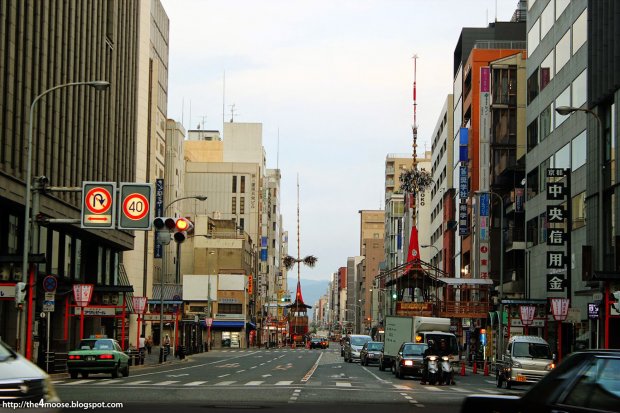
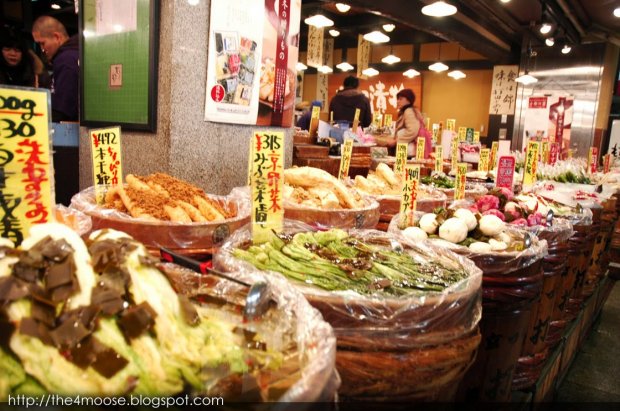
Nakagyo-ku is home to the Kitchen of Kyoto: Nishiki Market as well as the narrow alleyways of Pontocho.
Nakagyo-ku (中京区)| ****
This is the “downtown” of Kyoto, the area between Shijo-Karasuma and Shijo Kawaramachi (四条烏丸-四条河原町) is the main shopping area of Kyoto with luxury brands as well as home to the famed Tokyu Hands branch in Kyoto.
East Nakagyo-ku (Towards the River and Teramachi) | ****
Though not connected to the nation-wide JR network, the accessibility to buses and some private railway lines such as Keihan and Hankyu make it a the next best choice as a base of exploring Kyoto especially with many hostels and hotels located around here.
It is of walkable distance to many attractions such as Gion and Pontocho and on a good weather, it also possible to walk to Kiyomizu-dera and Kyoto Station. Otherwise, bus options provide easy connections to these places and beyond as well.
The Keihan Railway Line across the river provides connections to Uji and Kurama areas. This area is recommended as a base for exploring Kyoto and day trips to Kyoto’s outskirts via the Hankyu, Keihan and Eizan line networks. To get to Kyoto Station, you would either take a bus or transfer at Tofukuji Station.
Some accommodations in the area:
The Ritz Carlton, Kyoto – A luxury hotel in Kyoto, was built on the grounds of Ebisugawa-tei, a historical residence part of which was incorporated into the hotel.
Kyoto Hotel Okura – The tallest hotel around the area before the building height laws were implemented.
Tawara-ya Ryokan – A ryokan with at least 3 centuries of history. The late Steve Jobs stayed here before.
Hiiragiya Ryokan – Founded in 1818, this is the rival ryokan of Tawara-ya.
Ryokan Ishihara – A favourite ryokan of film director, Akira Kurosawa who directed Rashomon.
Khaosan Kyoto Guesthouse – A very affordable and reliable hostel along Teramachi-dori.
9Hours Teramachi – A designer capsule hotel.
Takasegawa Riverside Apartment (Airbnb)
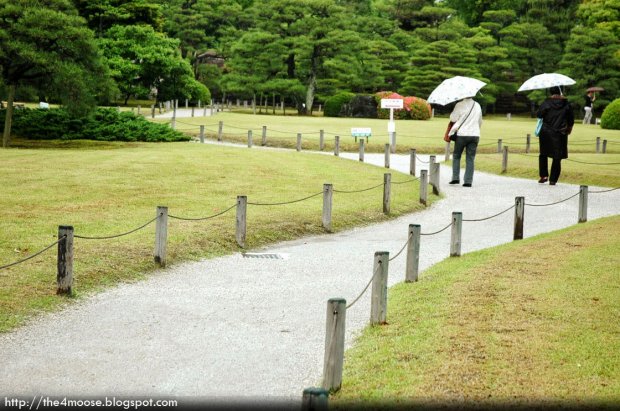
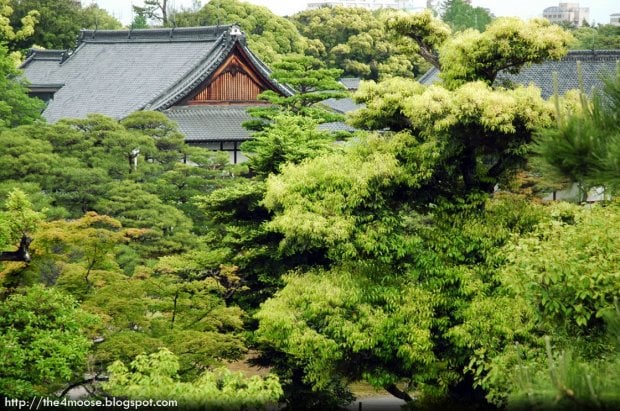
The famous attraction here is Nijo
Omiya-Nijo Area | ***
Another area with some hostels and Airbnb properties is around the Omiya area which is located in the west part of Nakagyo and comprises of the area around Nijo Castle. While it does not have access to the Keihan railway lines, it is possible to walk to JR Nijo Station and travel to Kyoto Station or Arashiyama if you are planning to stay in the Omiya area. There are also the Hankyu railway lines to travel to Katsura and Osaka. The subway also provides connection to Kawaramachi where you can walk over to Gion.
There are several buses that stop at Omiya which you could take to travel to Kinkakuji etc. Although, less convenient than Kyoto Station area and further away from the main Higashiyama area attractions, it is still a decent base for exploring Kyoto and a JR connection if you don’t mind some walking and transferring at Kyoto Station. The JR Nijo station is one of the stops for several limited express trains heading to Kinosaki Onsen as well.
Some accommodations in the area:
Crowne Plaza ANA Kyoto Hotel – A long time hotel of Kyoto with a beautiful lobby along with Kyoto Kokusai Hotel which closed in 2014. My late grandma stayed here in 70s.
Cotoriya Mibu Machiya
Konruri-an Machiya
Fushizome-an Machiya
Hostel Mundo
Kenichi Townhouse (Airbnb)
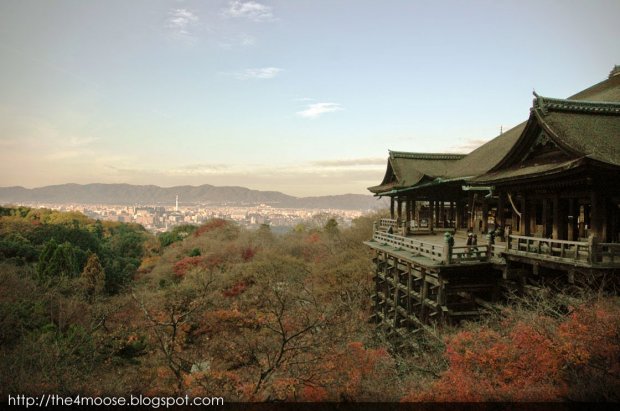
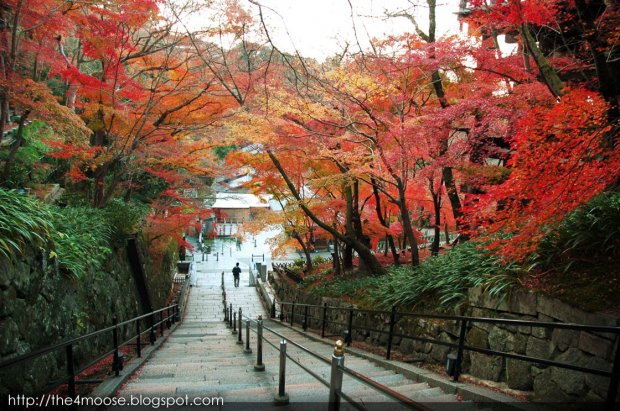
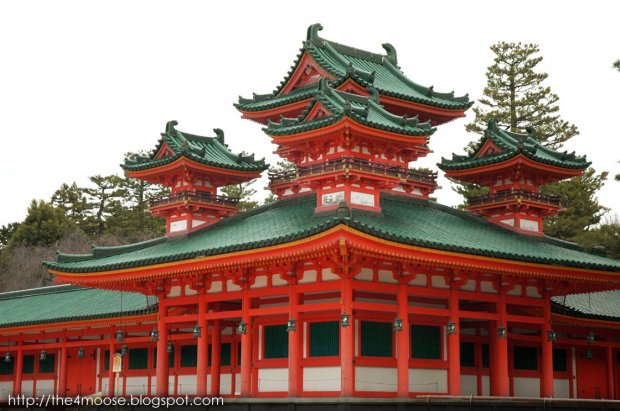
Kiyomizu-dera and the Heian Jingu are located within Higashiyama.
Higashiyama | ***
This area covers from Gingaku-ji all the way southwards to Kiyomizu-dera. Higashiyama has access to a number of bus services that allows travellers to get to Kyoto Station and central Kyoto with ease. The best base for Higashiyama is around Gion-Shijo and Sanjo-Keihan Stations where there is easy access to the Keihan railway line and city bus services. At the same time, these places are of walkable distance to central Kyoto where there are even more bus services and you could also make use of the subway as well as Hankyu lines to get to Umeda in Osaka.
Beyond Sanjo-Keihan and Gion Shijo areas, it is less accessible. Nonetheless, you would find several hotels, guesthouses and hostels around Higashiyama, especially around Gion.
Some accommodations in the area:
Hyatt Regency Kyoto – Hyatt’s only property in Kyoto. Before the Ritz Carlton this is one of the few modern luxury hotels in Kyoto.
The Westin Miyako Kyoto – Another grand dame hotel formerly known as the Miyako Hotel.
Gion Hatanaka Ryokan
Gion Fukuzumi Ryokan
Kyoto Ryokan “The Kinoe”
Ayado Gion
Roku Roku
IchiEn Sou
bAKpAK Gion Hostel
Tokuji’s Kyoto Gion House (Airbnb)
Tyo Apartment (Airbnb)
Kyoto Nene House
Samurai Machiya (Airbnb)
Yasuhiro Machiya (Airbnb)
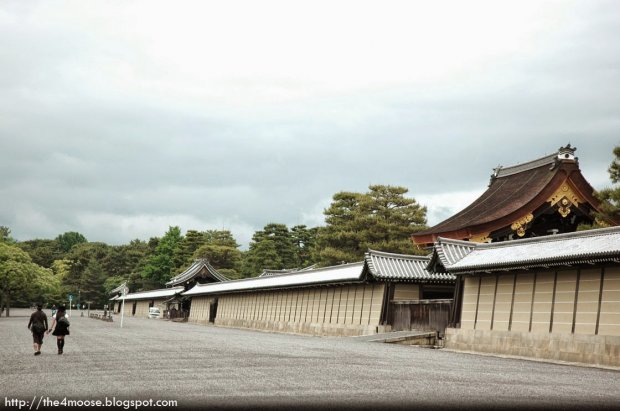
Located within the Kyoto Gyoen is the Kyoto Imperial Palace.
Kamigyō-ku (上京区)| **
This area covers the Kyoto Imperial Palace and extends up to Kitano Tenmangu. Its location to the north meant limited accessibility to the JR lines and the fastest connection is via the subway lines. A slower and cheaper option is the bus. As a base, this is not the best option in terms of transport but it could be good if you plan to cycle or get away from the busier Nakagyo and Shimogyo areas.
If you plan to visit Katsura Imperial Palace and Shugakuin Imperial Villa, the Imperial Household Agency where you would need to go to apply for their tours is located within the Imperial Palace Garden on Karasuma-dori side.
Some accommodations in the area:
Guesthouse Itoya Kyoto
Kyoto Brighton Hotel
Kyoto Heian Hotel
The Palace Side Hotel
Joshua Machiya (Airbnb)
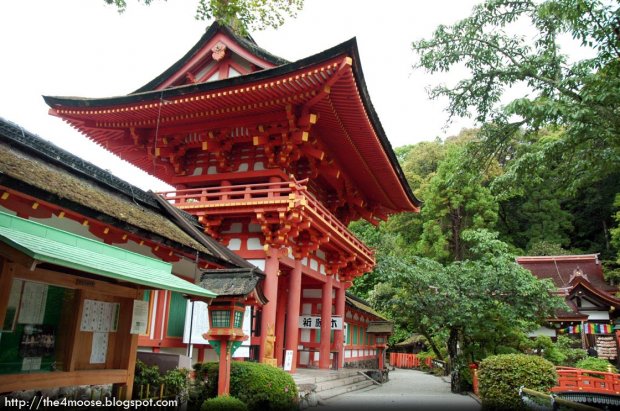
Northeast Kyoto | *
This area covers from the Kamigamo and Shimogamo Shrines as well as Ichijo-ji area. Bus connections are limited here and so are railway connections especially towards the north. The most important transport hubs around here is the Kitaoji Bus Terminal and the Demachiyanagi Station where you can take the Keihan Line to travel southwards along the river to Uji or Kyoto Station or take the Eizan Line northwards to Kurama and Ichijo-ji. The Kitaoji Bus Terminal has several bus services that allow you to travel around Kyoto.
Some accommodations in the area:
Grand Prince Hotel Kyoto – Designed by the late Togo Murano, an early modern architect.
Takumi Machiya (Airbnb)
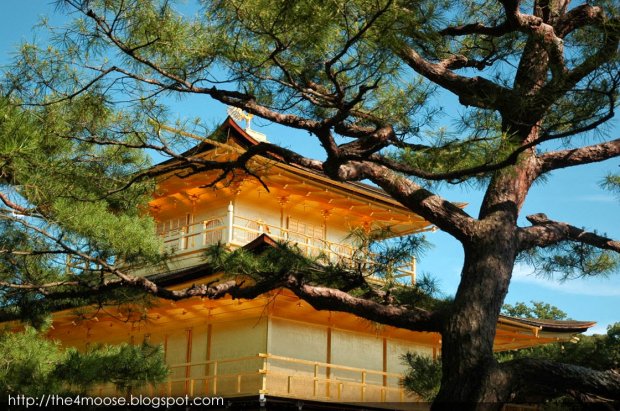
Northwest Kyoto | *
This area includes Utano and the famed Kinkaku-ji and Ginkaku-ji temples. Utano is where the Utano Youth Hostel is located. Similar to Northeast Kyoto, bus services is limited and the closest railway service is by the Randen Tramways that connects to Omiya in central Kyoto and Arashiyama.
Some accommodations in the area:
Utano Youth Hostel
Guesthouse Bon
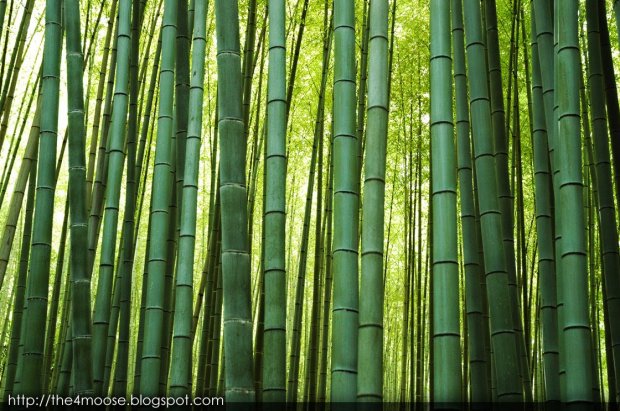
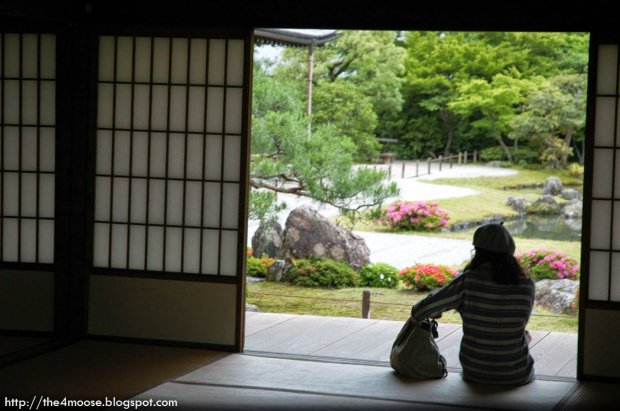
West Kyoto | **
If you don’t mind taking the train regularly or bus to get around Kyoto, Arashiyama is another probable base to explore Kyoto. There are several buses that are now covered by the 1 Day Bus Pass that serves Arashiyama. This is a scenic area of Kyoto and rather popular, therefore you would find some of the most expensive accommodations in Kyoto located here.
Some accommodations in the area:
Business Hotel Arashiyama
Oyama Guesthouse
Togetsutei
Arashiyama Benkei
Ryotei Rangetsu
Kyoto Ranzan
Hoshinoya Kyoto – A luxury ryokan by the Hoshino Resorts.
Kyoto Machiya Arashiyama Hanare (Airbnb)
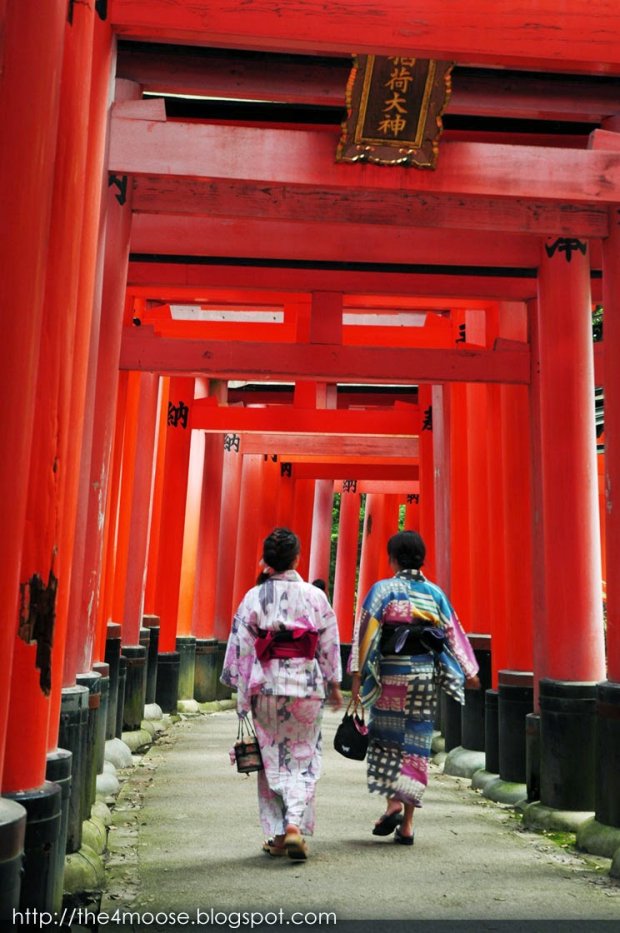
South Kyoto | **
South of Kyoto has limited bus coverage beyond Kujo Station. However, you would find several affordable Airbnb options around here and some hotels as well including the Hotel Anteroom Kyoto which is located a couple of blocks away from Kujo Station.
With a bicycle, it would be an easy ride to Kyoto Station and one of the perks for staying around here is that it is relatively quiet compared to Shimogyo-ku or Nakagyo-ku with a more neighbourhood-like atmosphere.
Some accommodations in the area:
Hotel Anteroom Kyoto – Designed by UDS Ltd. A designer boutique hotel + serviced apartments.
J-Hoppers Kyoto Guesthouse
Guesthouse Shitamachi-Kujo
Traditional Machiya by Hirofumi and Rina (Airbnb)
Riverside Machiya (Airbnb)
Also read: 20 Hotels in Japan That are Highly Raved by Travellers
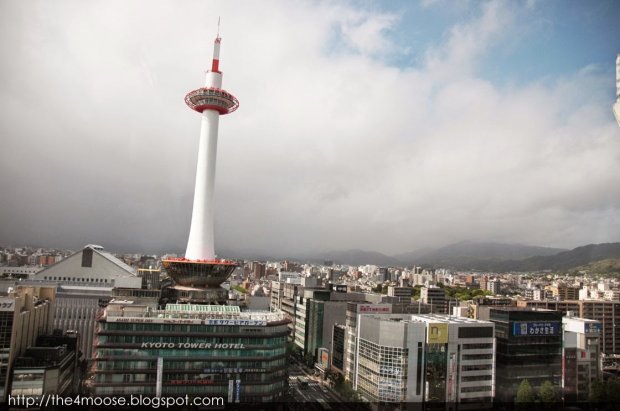
Planning for Kyoto
Here are some points and advice to consider while you decide where to stay and how much time to spend in Kyoto.
Picking the right base
Some places are more accessible than others and by picking a base with more transport options, not only it would give you more flexibility to get around Kyoto but also provide more alternatives in getting from point A to point B which might mean spending less time or money.
Explore Kyoto in clusters or by flow
The next point is how do you want to get around Kyoto to visit the sites? The major attractions in Kyoto are scattered all over the city but by grouping them into clusters or along a certain bus route perhaps, you would find yourself cutting down time spent on commuting and also saving on unnecessary spending from travelling all around Kyoto like attempting to visit Arashiyama in morning then Gingaku-ji in the afternoon followed by Katsura in the evening which are all located in different corners of Kyoto. An example of smarter planning of your sightseeing is to explore attractions close to each other like visiting Kinkaku-ji along with Ryoan-ji followed by Gingaku-ji then Gion.
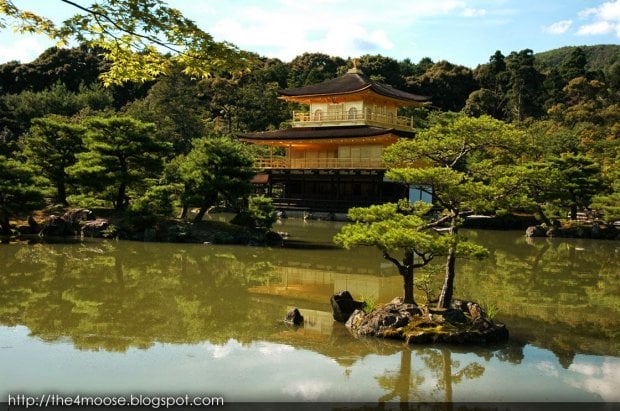
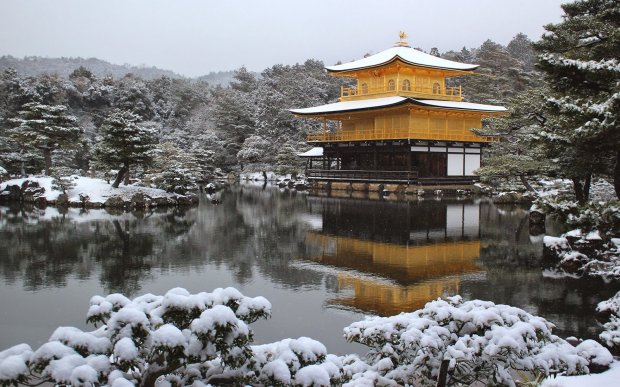
Take note of the seasons
The thing about the temperate countries is that different seasons provide different experiences and Kyoto in summer can be very different from Kyoto in winter in terms of food and appearance. This seasonal variation can be experienced by visiting Kinkakuji in different seasons or sampling local kyo-kaiseki cuisine.
More importantly, the different seasons affect the opening hours of the various attractions and you would need to take note of these while planning your sightseeing: shorter hours in winter and longer daylight in summer.
Furthermore, Kyoto is home to several major Japanese festivals and these festivals are worth checking out if you are planning to visit Kyoto when one is going on. One of the most famous festivals in Kyoto is the Gion Matsuri which takes place for the entire duration of July and do check it out. The festive period also meant peak periods in Kyoto so book ahead for your lodgings.
Temple fatigue
Too much of a good thing can be bad for some people. Kyoto is a treasure trove of historical architecture and many of these are found in temples and many of Kyoto’s major attractions are temples. Visiting all these temples without a break might wear out some travellers and to prevent that from happening, take a break and make day trips out of Kyoto or visit other areas in Kyoto in between to see a different side of Kyoto.
Also read: 5 Magnificent Temples You Must Visit in Kyoto, Japan
Take your time to explore Kyoto
On the surface, Kyoto seemed like a traditional Japanese city and the city is proud of that association with its long history and extremely rich culture and crafts scene. However, that is just one aspect of Kyoto and beneath that layer is a palimpsest or different layers of Kyoto which are waiting for you to explore. This is something a day trip or a two –day trip will not get to see.
Give yourself more time and you will find a vibrant coffee culture scene in Kyoto or a contemporary design hidden somewhere within the maze of alleys around Kyoto like a beautiful gallery, a designer craft shop or a bookshop with the latest design literature.
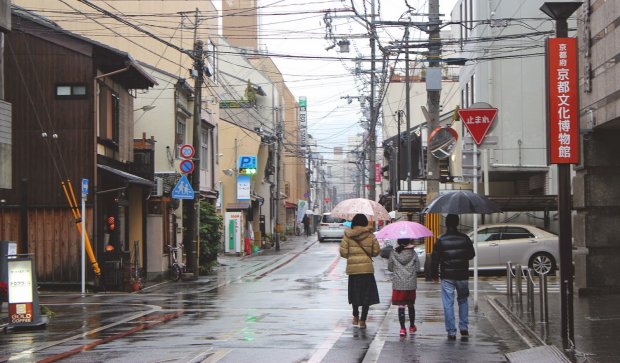
The Kansai dialect
Japanese speakers take note. The residents of Kyoto or rather Kansai Region speak a Kansai dialect (also known as the Kyoto-Osaka Dialect) that might be slightly different from the Tokyo dialect which form the basis of Standard Japanese commonly taught in Japanese classes.
Historically, up until the shift of the base of power to Edo in the Tokugawa Period, the Kansai dialect was the de facto standard Japanese, hence the dialect forms an important element of regional cultural identity for the locals of the Kansai region including Kyoto quite like our Hokkien and Teochew dialects demonstrates our different regional roots among the Chinese populace in Singapore
Hence, if you are planning to speak Japanese in Kyoto or in the Kansai region, expect some differences. Some of examples of Kansai dialects are:
“おおきに!” (Ookini!) – Thank You! This is the most commonly heard phrase in restaurants, shops etc.
“おやすみやす.” (Oyasumiyasu.) – Good Night. (Used in Kyoto and Shiga by the older generations)
“ほな なあ!” (Hona nā!) – See You! (In Standard Japanese, it would be “じゃあね!” [Jā ne! ] )
“ほんまぁ?” (Hon ma~a?) – “Really?” (In Standard Japanese, it would be”本当?” [Hontō?] )
The website, Kansai-ben, shows how the Kansai dialect and Standard Japanese sounded differently in various contexts.
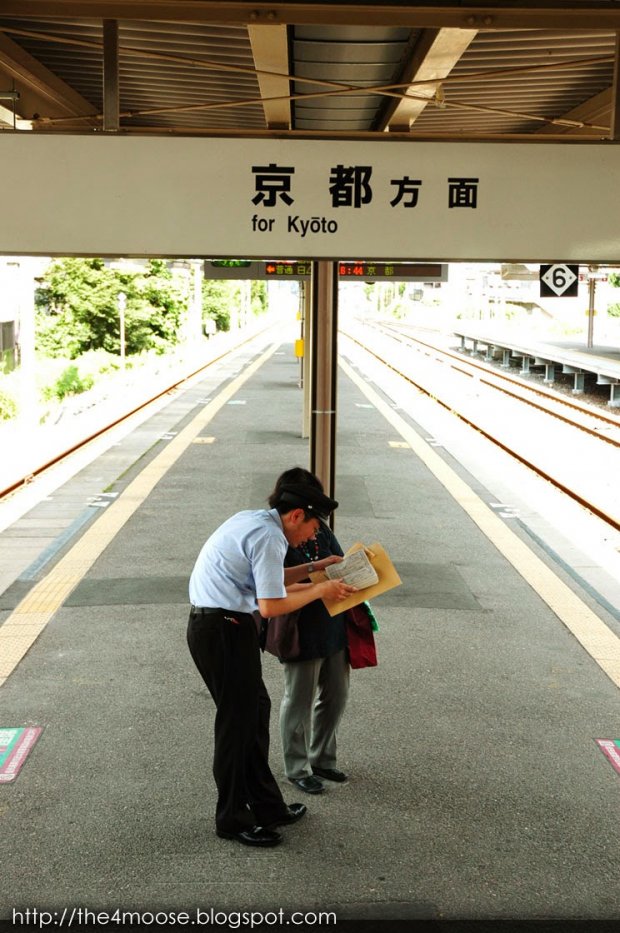
In the next part, I will share with you what to do, what to eat, what to see, what to buy in Kyoto for your further planning on exploration of Kyoto and show you more of this amazing city that is not just about geiko (as geishas are known in Kyoto), temples and matcha.
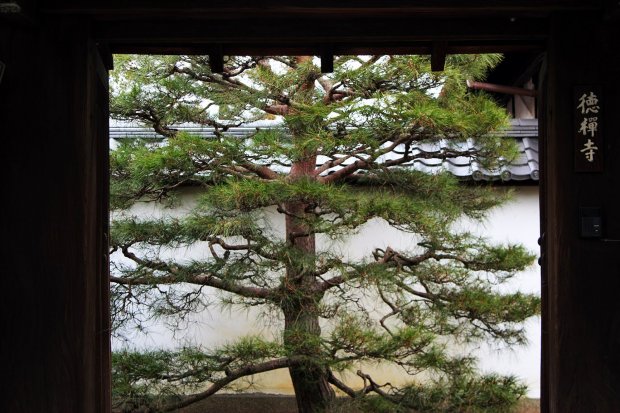
Daitokuji
For further reading about travel in Japan you can check out my previous posts:
Advice on the Japan Rail Pass
Costs Costs Costs
Other websites that would be useful references for your travel-planning to Japan & Kyoto are:
Inside Kyoto: An in-depth travel guide to many aspects of Kyoto.
Kyoto Travel Guide: for a broad overview of what Kyoto has to offer.
Kyoto Guide: a monthly and informative guide that updates you on what to look out for in the coming month in Kyoto.
Japan-guide: A concise and useful guide for travelling in Kyoto and Japan.
A highly recommended read before heading to Kyoto is In Praise of Shadows (陰翳礼讃) written by Japanese author and novelist Jun’ichirō Tanizaki (谷崎 潤一郎).
Also read: My Japan Kyoto Leg Made Me Want to Crawl Through A Pillar
Contributed by Pok Pok and Away.





